DIALOGUE WITH THE NEIGHBOURHOOD
KadS 2011 [Kunst aan de Schinkel]
The first edition of KadS [Kunst aan de Schinkel/Art at the Schinkel], a cultural event in the Schinkel neighbourhood, will take place from 18th September till 30th October 2011 in south Amsterdam.
Simone Kukenheim, the Chairman of the Culture Committee, south Amsterdam, will open the exhibition on Sunday 18th September at 15:00 hrs at the Soledad Senlle Gallery.
A group of twenty national and international artists reflect, from their respective art disciplines, on the neighbourhood and its inhabitants. Young artists at the beginning of their careers as well as established artists, who have already made their mark, will show their work, which has been specifically created for the public space alongside the river Schinkel.
With this art project, initiator Marisol Ferradás, of Soledad Senlle Gallery, aims to create social cohesion in the neighbourhood. Emphasising local aspects of this neighbourhood through contemporary art has led to a variety of surprising views on the neighbourhood. Not only does the history of this neighbourhood get a look in, but also contemporary, everyday life. Art unsettles, it astonishes and makes something, which was invisible, visible. It offers the visitor a different perspective on the daily reality of life along the Schinkel. The distinction between art and life fades away and brings people together, something, which is essential for a lively neighbourhood.
The artistic interventions take on various forms and vary from performance art, installations, a musical act and workshops. Interaction with the public is an important function in this event. Helen Morse Palmer has worked with local community groups, collecting questions and answers, which she has incorporated into her performance. The legendary Nederlandsche Cocaïnefabriek [Dutch Cocaine Factory] stood along the Schinkel at the beginning of the 20th century. Go Eun Im has made an artwork referring to this factory, a building, which we now cannot imagine having ever existed. The other artworks are spread across various locations along the Sloterkade and Schinkelkade.
The Soledad Senlle Gallery functions as a central point for the event, where the catalogue and further information will be available. Here, in the framework of this event, is also a solo exhibition from Saskia Noor van Imhoff, in which she presents a careful selection of fragments from Kunst aan de Schinkel artworks.
Participating artists:
Margit Aba, Maze de Boer, Jasper van den Brink, Peter Cleutjens, Go Eun Im, Saskia Noor van Imhoff, Marisol Ferradás, Jasper Griepink, Christina Della Guistina - Cees de Boer, Doina Kraal, Joanneke Meester, Alberto De Michele, Helen Morse Palmer, Hester Oerlemans, Natasha Rosling, Theo Tomson, Mischa Rakier and Peter Vink.
Oorbeek, a collective of theoreticians, artists and musicians, will festively usher in the event’s opening.
During this Arts and Culture event, special places in the Schinkel neighbourhood will be brought to the public’s attention, such as the Huis te Vraag cemetery, a historic cultural monument, which is an artwork in itself.
KadS is accessible to the public and free of charge.
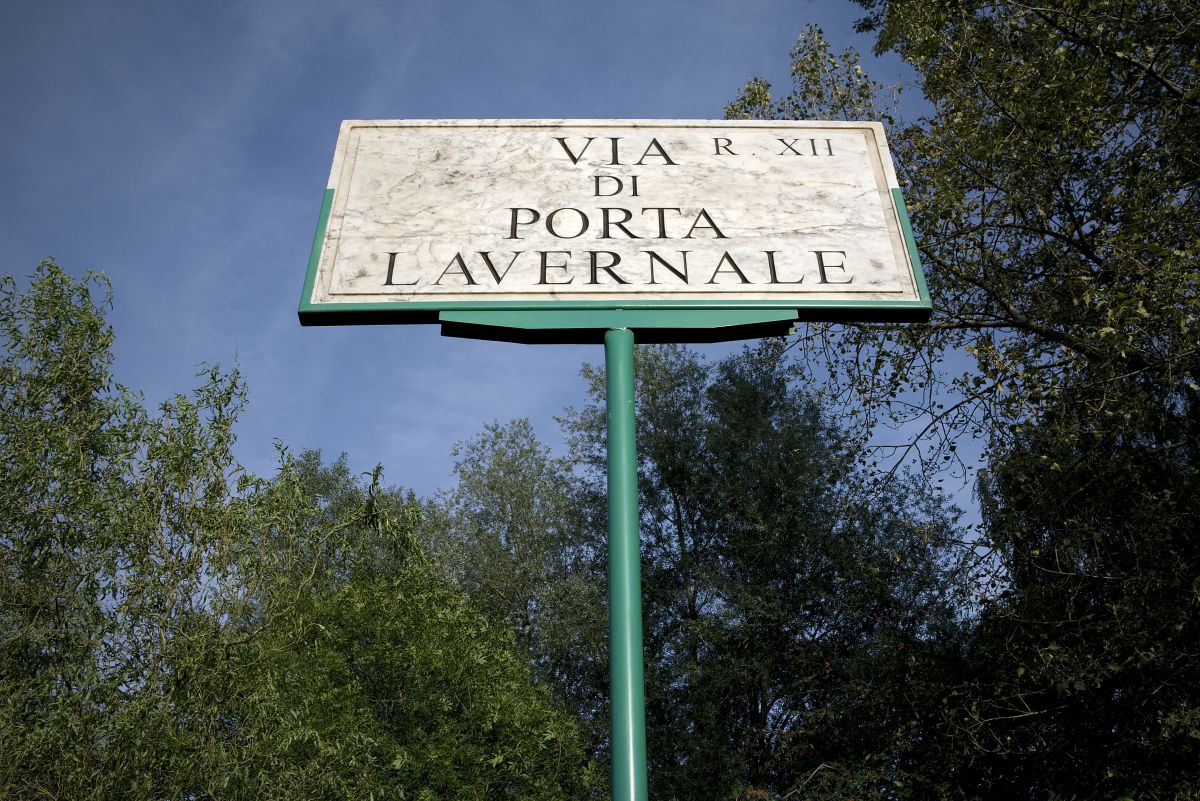
Alberto De Michele (IT/NL) VIA DI PORTA LAVERNALE, 2011
marble 100 × 50 cm – steel 250 cm,
Spijtellaantje, Amsterdam
In Roman mythology, Laverna was the goddess of thieves, robbers and crooks. Criminals would bring her sacrifices in exchange for her protection during their illegal activities. Laverna used to have her own sanctuary in Rome, on Aventine Hill near one of the city gates, the Porta Lavernalis. Now, there is a street there called the ‘Via di Porta Lavernale’. Before going out to steal, thieves would come here to receive Laverna’s blessing. It was also a place where criminals would conceal themselves in the bushes and exchange stolen goods.
For the Kunst aan de Schinkel project, Alberto De Michele has produced an exact copy of the marble street sign of the Via di Porta Lavernale. He then swapped the original,
which hangs in Rome, with his own copy. The original street sign is now on view in the Spijtellaantje in Amsterdam, in a quiet area along the Schinkel, next to the old cemetery Huis te Vraag. You can see remarkable similarities between these two areas if you look at old maps of Rome and Amsterdam. The artist feels that the Spijtellaantje could also have been a safe haven, where Amsterdam outlaws could have gathered. The idea of stealing and replacing the street sign dedicated to the name of the goddess and displaying it in the Spijtellaantje is a tribute to mythology and the power of deception.
The work of the Italian/Dutch artist Alberto De Michele [Venice, 1980] treads the precarious boundary between fact and fiction. It is the result of research into the romanticised ideas about the culture of the outlaw and criminals in connection with his own personal experiences within this world, which he partly grew up in, because of his father. Alberto De Michele is currently artist-in-residence at the Rijksakademie.
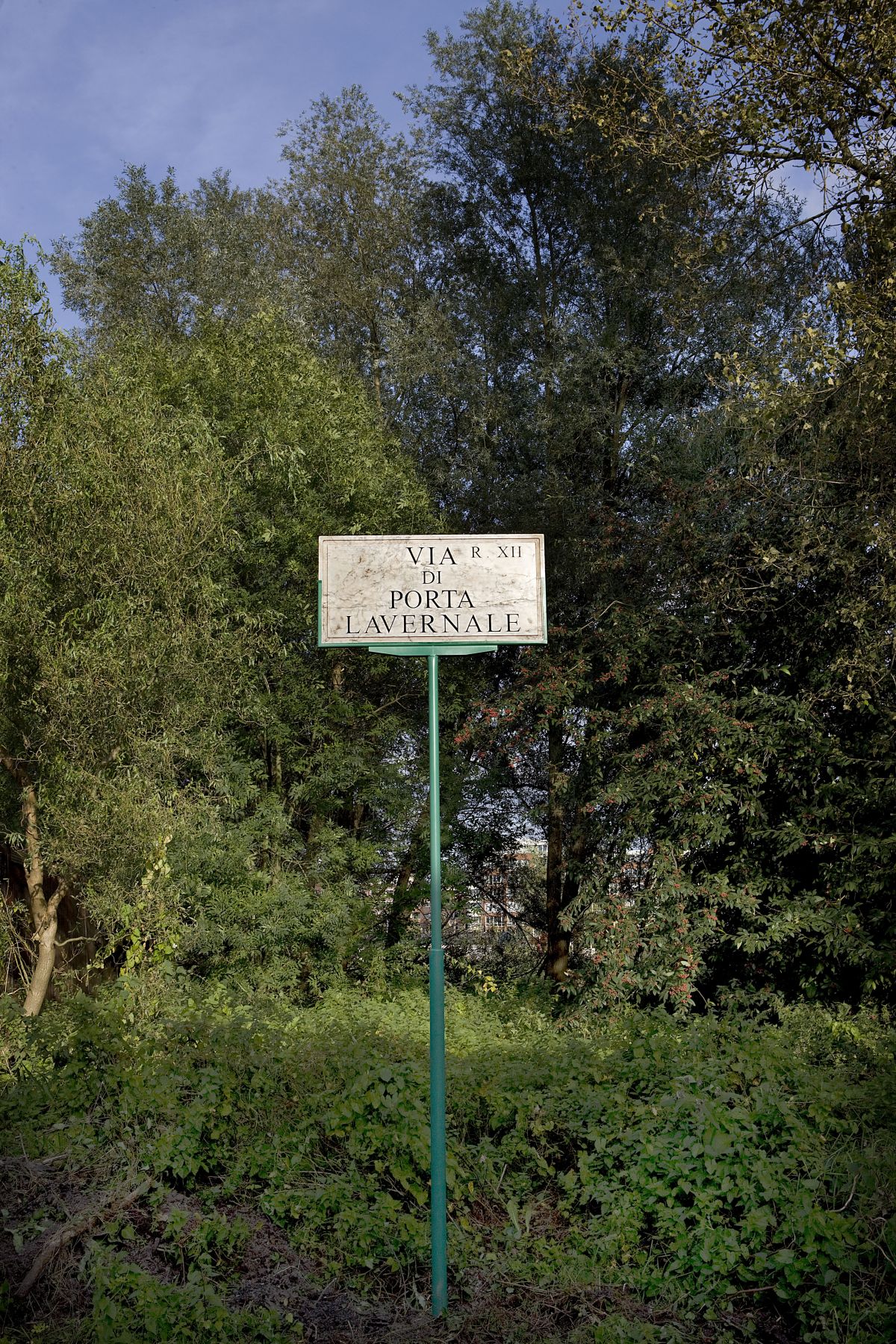
Alberto De Michele (IT/NL) VIA DI PORTA LAVERNALE, 2011
marble 100 × 50 cm – steel 250 cm,
Spijtellaantje, Amsterdam
In Roman mythology, Laverna was the goddess of thieves, robbers and crooks. Criminals would bring her sacrifices in exchange for her protection during their illegal activities. Laverna used to have her own sanctuary in Rome, on Aventine Hill near one of the city gates, the Porta Lavernalis. Now, there is a street there called the ‘Via di Porta Lavernale’. Before going out to steal, thieves would come here to receive Laverna’s blessing. It was also a place where criminals would conceal themselves in the bushes and exchange stolen goods.
For the Kunst aan de Schinkel project, Alberto De Michele has produced an exact copy of the marble street sign of the Via di Porta Lavernale. He then swapped the original,
which hangs in Rome, with his own copy. The original street sign is now on view in the Spijtellaantje in Amsterdam, in a quiet area along the Schinkel, next to the old cemetery Huis te Vraag. You can see remarkable similarities between these two areas if you look at old maps of Rome and Amsterdam. The artist feels that the Spijtellaantje could also have been a safe haven, where Amsterdam outlaws could have gathered. The idea of stealing and replacing the street sign dedicated to the name of the goddess and displaying it in the Spijtellaantje is a tribute to mythology and the power of deception.
The work of the Italian/Dutch artist Alberto De Michele [Venice, 1980] treads the precarious boundary between fact and fiction. It is the result of research into the romanticised ideas about the culture of the outlaw and criminals in connection with his own personal experiences within this world, which he partly grew up in, because of his father. Alberto De Michele is currently artist-in-residence at the Rijksakademie.
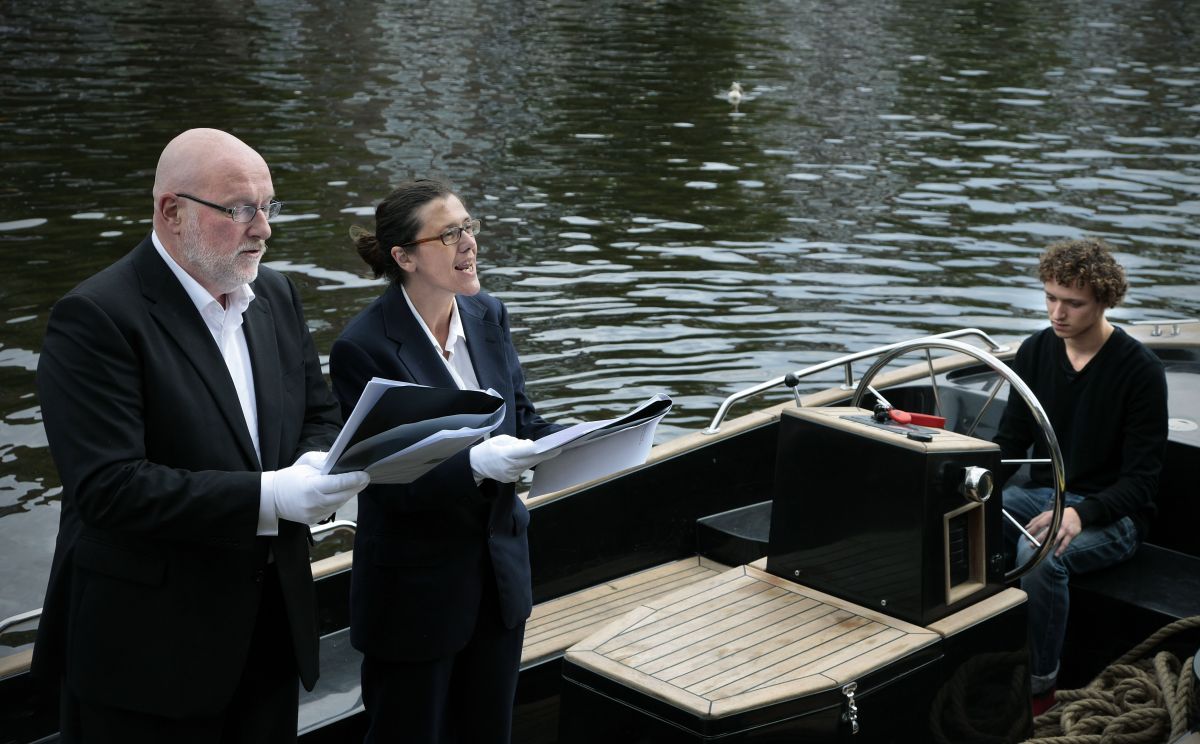
Christina Della Giustina & Cees de Boer (CH/NL) Alnus glutinosa, Carpinus betulus, Acer pseudoplatanus, 2011
Performance and Christina Della Giustina, book/mixed media,
Sloterkade 171, Amsterdam
For the Kunst aan de Schinkel project, Christina Della Giustina and Cees de Boer have collaborated in the form of a performance, reciting from a book made specifically for the event. Della Giustina wrote the book ‘Alnus glutinosa, Carpinus betulus, Acer pseudoplatanus’ [black alder, hornbeam and sycamore] about the trees along the Sloterkade and Schinkelkade quays. In this project the trees are the artists as they were the guides who led to the work’s creation. The book deals with the relations between the eco-physiological processes in the trees and the creative processes of the collaborating artists. Della Giustina and de Boer will recite parts of the book as a dialogue during the performance. One will recite from the quay to a boat on the water and the other will recite from the boat to the quay, in this way addressing the trees. The book [editie 2] is available for sale, on request, at the Soledad Senlle Gallery.
Christina Della Giustina [Schaffhausen, Switzerland, 1965] lives and works in Amsterdam. She studied Philosophy, Art History and Linguistics in Zürich and New Media at the
Jan van Eyck Academie in Maastricht. She has presented her work in international solo and group exhibitions in countries such as the Netherlands, Belgium, France, Italy, the UK, Switzerland, Canada and China. She has been teaching Digital Media at the Visual Arts and Design faculty of the HKU in Utrecht since 2000.
Cees de Boer [The Hague, 1955] studied Dutch, Literary Theory and Philosophy and obtained his doctorate in 1995 on the collage novels of Max Ernst. He is a freelance publicist and exhibition organiser and has worked with an array of artists including Sjoerd Buisman, herman de vries and Ulay. He is currently preparing a philosophical study of the work of herman de vries and also performs as an actor and singer.
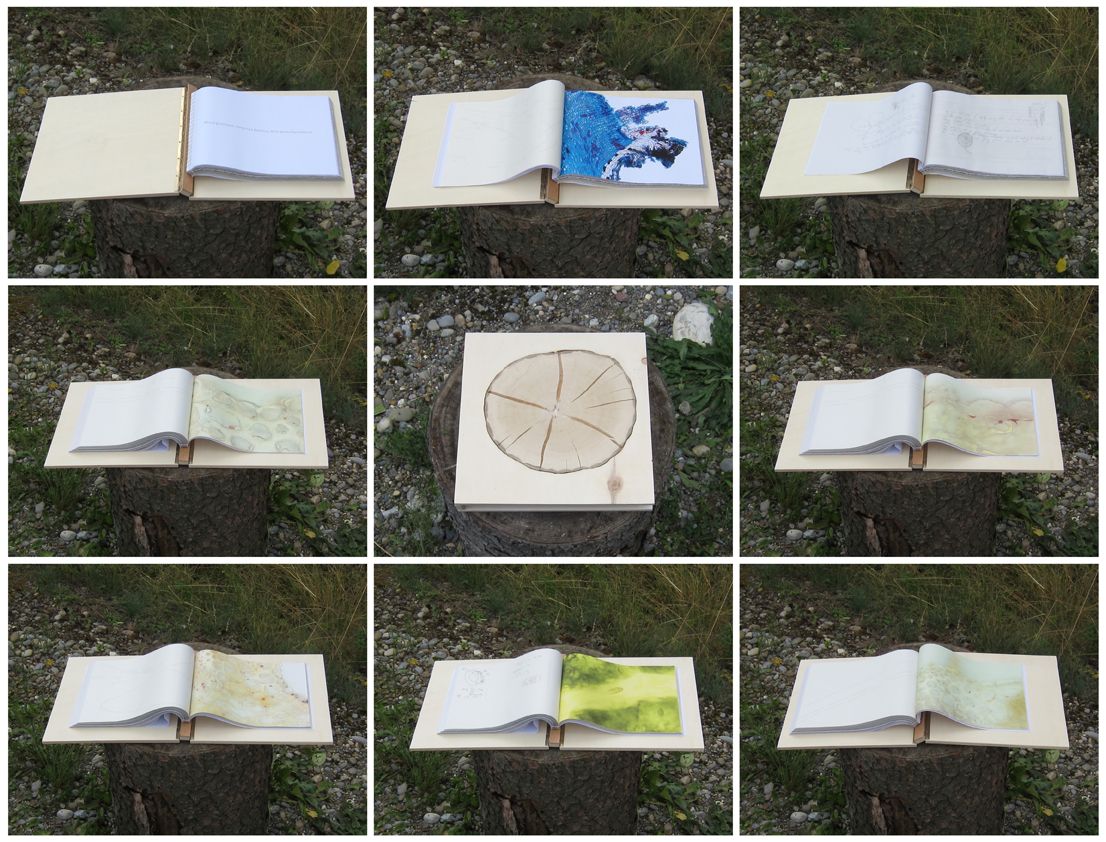
Christina Della Giustina & Cees de Boer (CH/NL) Alnus glutinosa, Carpinus betulus, Acer pseudoplatanus, 2011
Performance and Christina Della Giustina, book/mixed media,
Sloterkade 171, Amsterdam
For the Kunst aan de Schinkel project, Christina Della Giustina and Cees de Boer have collaborated in the form of a performance, reciting from a book made specifically for the event. Della Giustina wrote the book ‘Alnus glutinosa, Carpinus betulus, Acer pseudoplatanus’ [black alder, hornbeam and sycamore] about the trees along the Sloterkade and Schinkelkade quays. In this project the trees are the artists as they were the guides who led to the work’s creation. The book deals with the relations between the eco-physiological processes in the trees and the creative processes of the collaborating artists. Della Giustina and de Boer will recite parts of the book as a dialogue during the performance. One will recite from the quay to a boat on the water and the other will recite from the boat to the quay, in this way addressing the trees. The book [editie 2] is available for sale, on request, at the Soledad Senlle Gallery.
Christina Della Giustina [Schaffhausen, Switzerland, 1965] lives and works in Amsterdam. She studied Philosophy, Art History and Linguistics in Zürich and New Media at the
Jan van Eyck Academie in Maastricht. She has presented her work in international solo and group exhibitions in countries such as the Netherlands, Belgium, France, Italy, the UK, Switzerland, Canada and China. She has been teaching Digital Media at the Visual Arts and Design faculty of the HKU in Utrecht since 2000.
Cees de Boer [The Hague, 1955] studied Dutch, Literary Theory and Philosophy and obtained his doctorate in 1995 on the collage novels of Max Ernst. He is a freelance publicist and exhibition organiser and has worked with an array of artists including Sjoerd Buisman, herman de vries and Ulay. He is currently preparing a philosophical study of the work of herman de vries and also performs as an actor and singer.
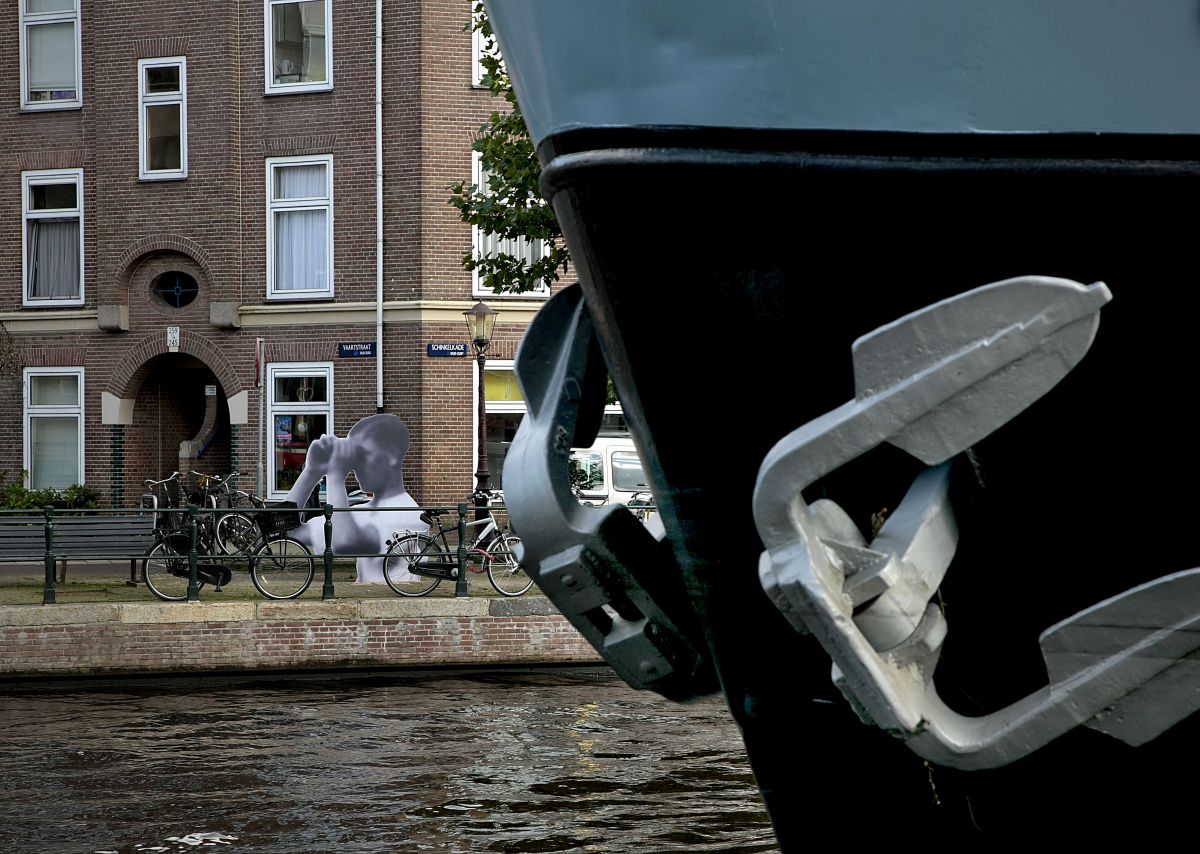
Doina Kraal (NL) Gemist - Broertje, 2011
Coated steel, inkjet vinyl, 190 × 223 cm,
Schinkelkade, Amsterdam
Doina Kraal creates installations in which she uses various mediums such as video, photography, sculpture and sound. Over the past two years, the artist has made a range
of photographic sculptures using images from the archives of her [great] grandparents. Kraal cuts out elements from archive photos and places them in a new environment, as photographic sculptures.
For the Kunst aan de Schinkel project, Doina Kraal met with the residents of the nursing home Schinkelhaven, and spoke with them about their past and what their ideal view would be in terms of what they can imagine or remember. Kraal is curious to see what may or may not be missing from the residents’ current view. She has allowed
her selection of photographs to be influenced by these discussions and has used them to create two new photographic sculptures, which will be placed on two locations along the quay.
In her work Doina Kraal combines different realities in order to create her own personal environment. Deeply fascinated and inspired by the past, aspects of her work refer to her own memories or histories. With her work, she shows how reinterpretations of events and memories can affect our perception of reality.
Doina Kraal [Breukelen, 1980] studied at the Gerrit Rietveld Academy in Amsterdam and Central Saint Martins College of Art and Design in London. She has exhibited on an international level in institutions such as the Point Blank Gallery, Johannesburg 2005, Times Square Gallery New York 2008, and more recently at the Glazen Huis in Amsterdam and the Der Aa-kerk in Groningen.
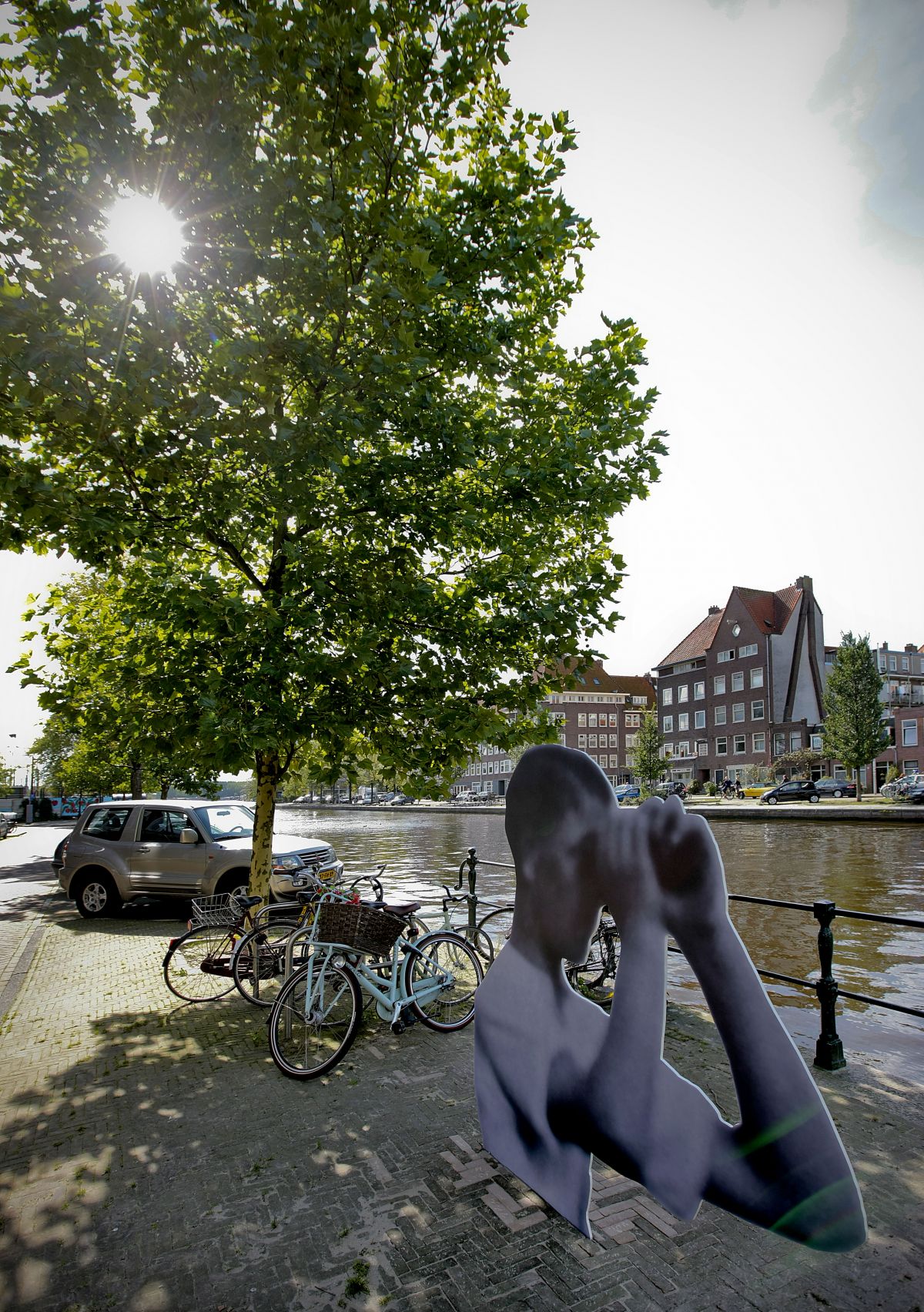
Doina Kraal (NL) Gemist - Broertje, 2011
Coated steel, inkjet vinyl, 190 × 223 cm,
Schinkelkade, Amsterdam
Doina Kraal creates installations in which she uses various mediums such as video, photography, sculpture and sound. Over the past two years, the artist has made a range
of photographic sculptures using images from the archives of her [great] grandparents. Kraal cuts out elements from archive photos and places them in a new environment, as photographic sculptures.
For the Kunst aan de Schinkel project, Doina Kraal met with the residents of the nursing home Schinkelhaven, and spoke with them about their past and what their ideal view would be in terms of what they can imagine or remember. Kraal is curious to see what may or may not be missing from the residents’ current view. She has allowed
her selection of photographs to be influenced by these discussions and has used them to create two new photographic sculptures, which will be placed on two locations along the quay.
In her work Doina Kraal combines different realities in order to create her own personal environment. Deeply fascinated and inspired by the past, aspects of her work refer to her own memories or histories. With her work, she shows how reinterpretations of events and memories can affect our perception of reality.
Doina Kraal [Breukelen, 1980] studied at the Gerrit Rietveld Academy in Amsterdam and Central Saint Martins College of Art and Design in London. She has exhibited on an international level in institutions such as the Point Blank Gallery, Johannesburg 2005, Times Square Gallery New York 2008, and more recently at the Glazen Huis in Amsterdam and the Der Aa-kerk in Groningen.
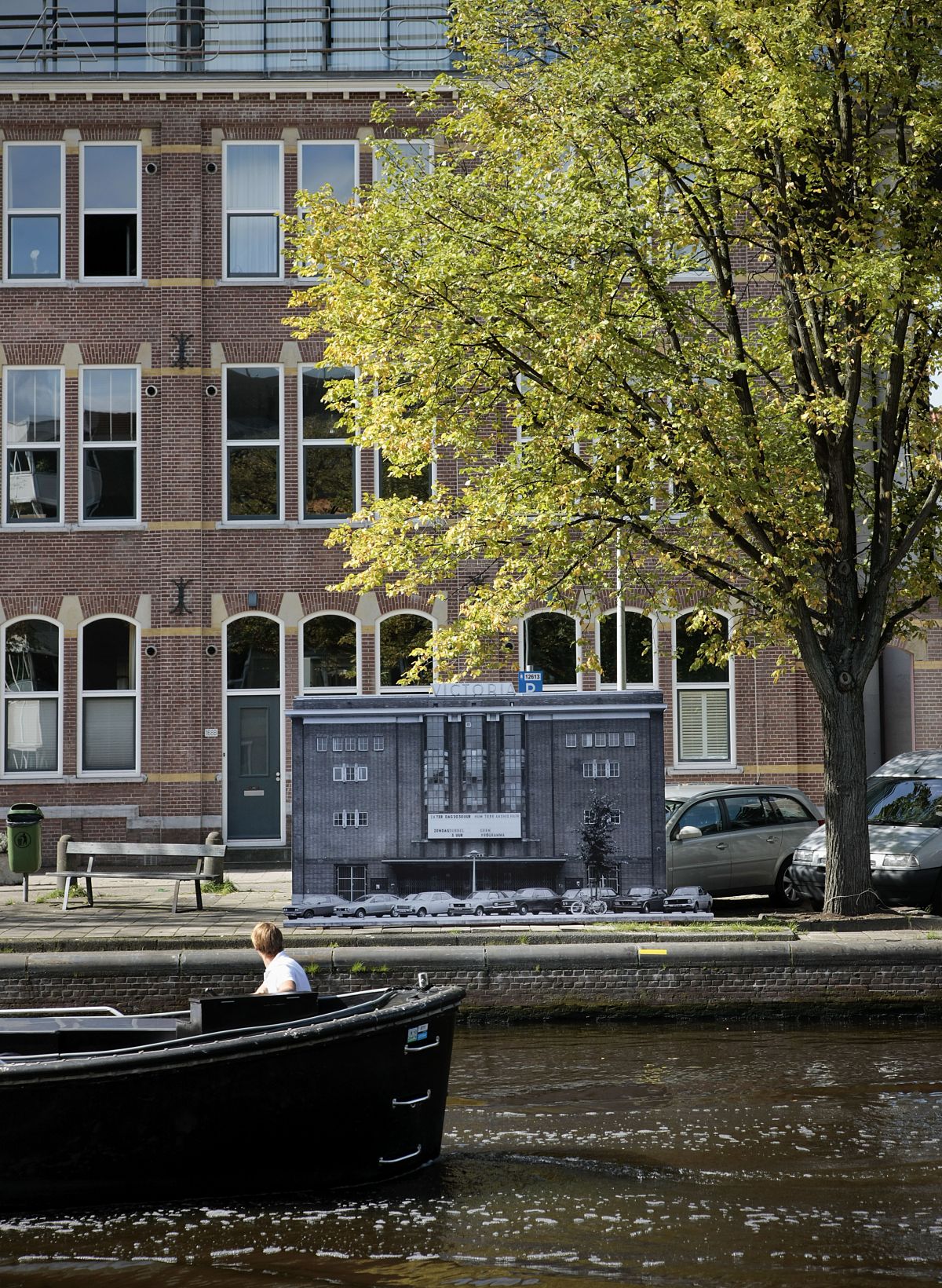
Doina Kraal (NL) Gemist - Victoria Bioscoop, 2011
Plywood and inkjet vinyl, 250 × 450 cm,
Sloterkade 171, Amsterdam
Doina Kraal creates installations in which she uses various mediums such as video, photography, sculpture and sound. Over the past two years, the artist has made a range
of photographic sculptures using images from the archives of her [great] grandparents. Kraal cuts out elements from archive photos and places them in a new environment, as photographic sculptures.
For the Kunst aan de Schinkel project, Doina Kraal met with the residents of the nursing home Schinkelhaven, and spoke with them about their past and what their ideal view would be in terms of what they can imagine or remember. Kraal is curious to see what may or may not be missing from the residents’ current view. She has allowed
her selection of photographs to be influenced by these discussions and has used them to create two new photographic sculptures, which will be placed on two locations along the quay.
In her work Doina Kraal combines different realities in order to create her own personal environment. Deeply fascinated and inspired by the past, aspects of her work refer to her own memories or histories. With her work, she shows how reinterpretations of events and memories can affect our perception of reality.
Doina Kraal [Breukelen, 1980] studied at the Gerrit Rietveld Academy in Amsterdam and Central Saint Martins College of Art and Design in London. She has exhibited on an international level in institutions such as the Point Blank Gallery, Johannesburg 2005, Times Square Gallery New York 2008, and more recently at the Glazen Huis in Amsterdam and the Der Aa-kerk in Groningen.
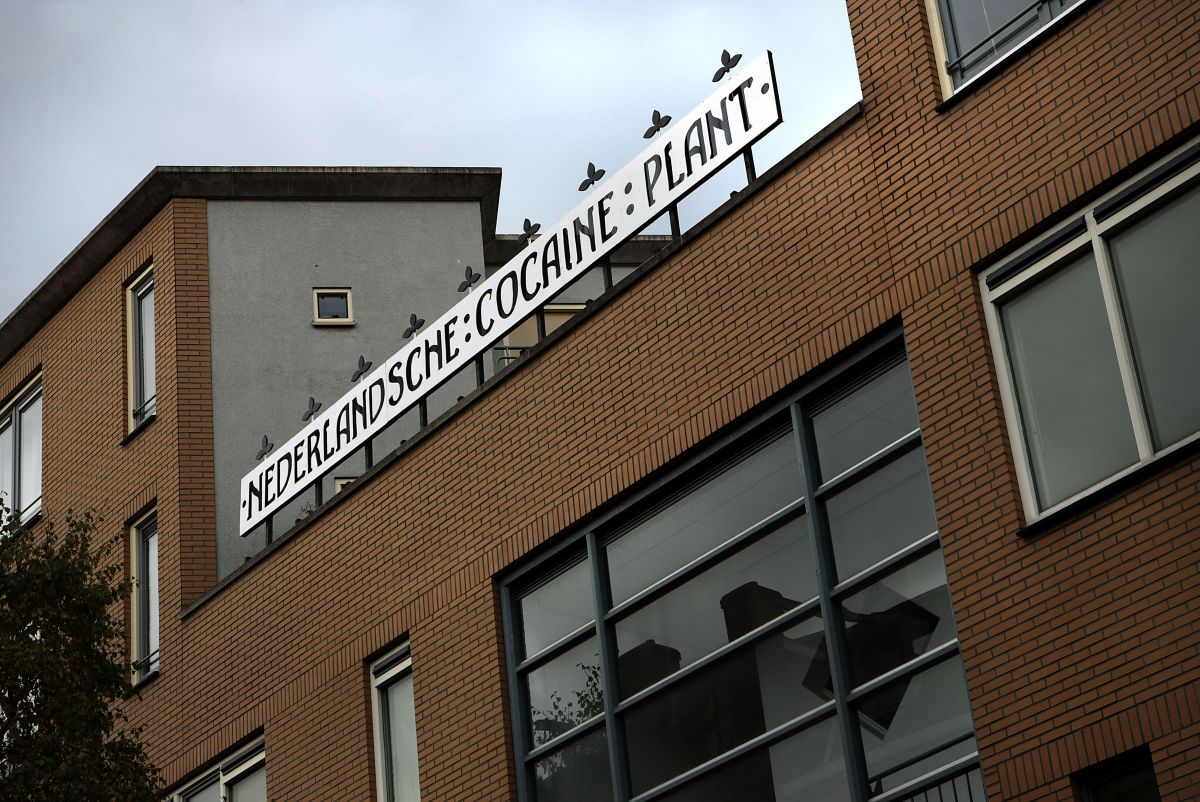
Go Eun Im (KO) NEDERLANDSCHE COCAÏNEFABRIEK, 2011
Mixed media installation,
Schinkelkade opposite #20, Amsterdam
For her contribution to the Kunst aan de Schinkel project, the South Korean artist Go Eun Im was inspired by the Dutch Cocaine Factory [Nederlandsche Cocaïnefabriek]. The early 20th century factory, situated on the corner of the Eerste Schinkelstraat and the Schinkelkade, produced cocaine for medicinal, military and recreational purposes from coca plants cultivated in the Dutch East Indies. Even though the factory’s activities were not made public knowledge, it had managed to develop into the world’s largest factory by 1910. Not long afterwards, the factory was relocated to accommodate its explosive growth and enable further expansion. Im is fascinated that there was once an official factory in Amsterdam that produced, what are now, prohibited drugs. Few people living in Amsterdam and in the Schinkel area are aware of these historical facts. The artist has carried out thorough research into stories and images from historic publications and archives, which have formed the source for her project for Kunst aan de Schinkel. By playing with the image in communication, representation and compilation of objects, Go Eun Im aims to revive the history of the factory and to put visitors on the wrong track. The information from the past will certainly be tested against today’s view.
Go Eun Im [Sangchen, 1981] studied at the Yonsei University, Graduate School of Communication and Art [MFA in Media Art] in Seoul, and was artist in residence at the Rijksakademie voor Beeldende Kunsten in Amsterdam in 2008/2009. Go Eun Im lives in Amsterdam and exhibits in the Netherlands and abroad. In 2010, she won the public award: The NEW MEDIA AWARD of the Liedts-Meesen Foundation, Update III, in Ghent, Belgium.
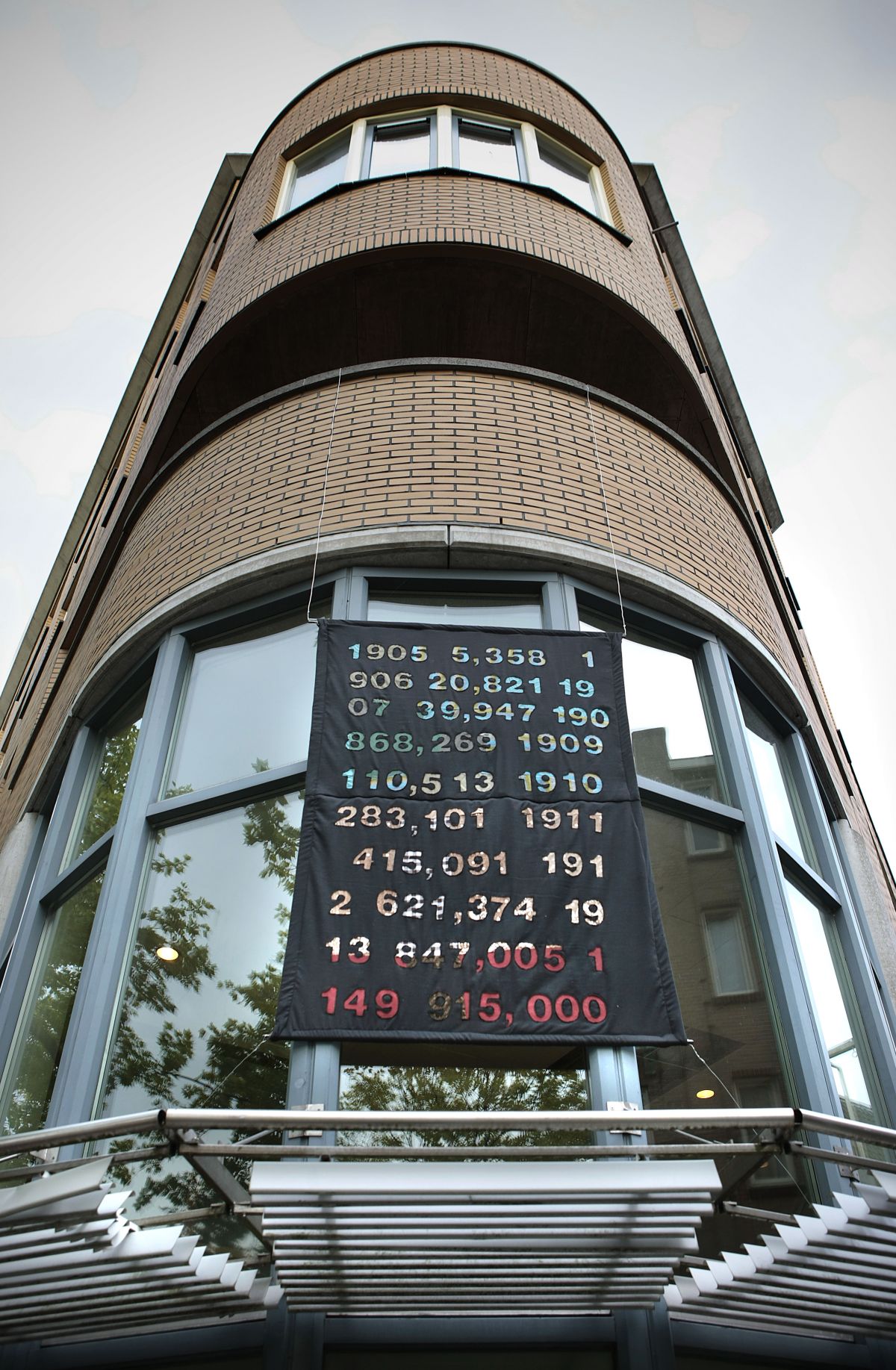
Go Eun Im (KO) NEDERLANDSCHE COCAÏNEFABRIEK, 2011
Mixed media installation,
Schinkelkade opposite #20, Amsterdam
For her contribution to the Kunst aan de Schinkel project, the South Korean artist Go Eun Im was inspired by the Dutch Cocaine Factory [Nederlandsche Cocaïnefabriek]. The early 20th century factory, situated on the corner of the Eerste Schinkelstraat and the Schinkelkade, produced cocaine for medicinal, military and recreational purposes from coca plants cultivated in the Dutch East Indies. Even though the factory’s activities were not made public knowledge, it had managed to develop into the world’s largest factory by 1910. Not long afterwards, the factory was relocated to accommodate its explosive growth and enable further expansion. Im is fascinated that there was once an official factory in Amsterdam that produced, what are now, prohibited drugs. Few people living in Amsterdam and in the Schinkel area are aware of these historical facts. The artist has carried out thorough research into stories and images from historic publications and archives, which have formed the source for her project for Kunst aan de Schinkel. By playing with the image in communication, representation and compilation of objects, Go Eun Im aims to revive the history of the factory and to put visitors on the wrong track. The information from the past will certainly be tested against today’s view.
Go Eun Im [Sangchen, 1981] studied at the Yonsei University, Graduate School of Communication and Art [MFA in Media Art] in Seoul, and was artist in residence at the Rijksakademie voor Beeldende Kunsten in Amsterdam in 2008/2009. Go Eun Im lives in Amsterdam and exhibits in the Netherlands and abroad. In 2010, she won the public award: The NEW MEDIA AWARD of the Liedts-Meesen Foundation, Update III, in Ghent, Belgium.
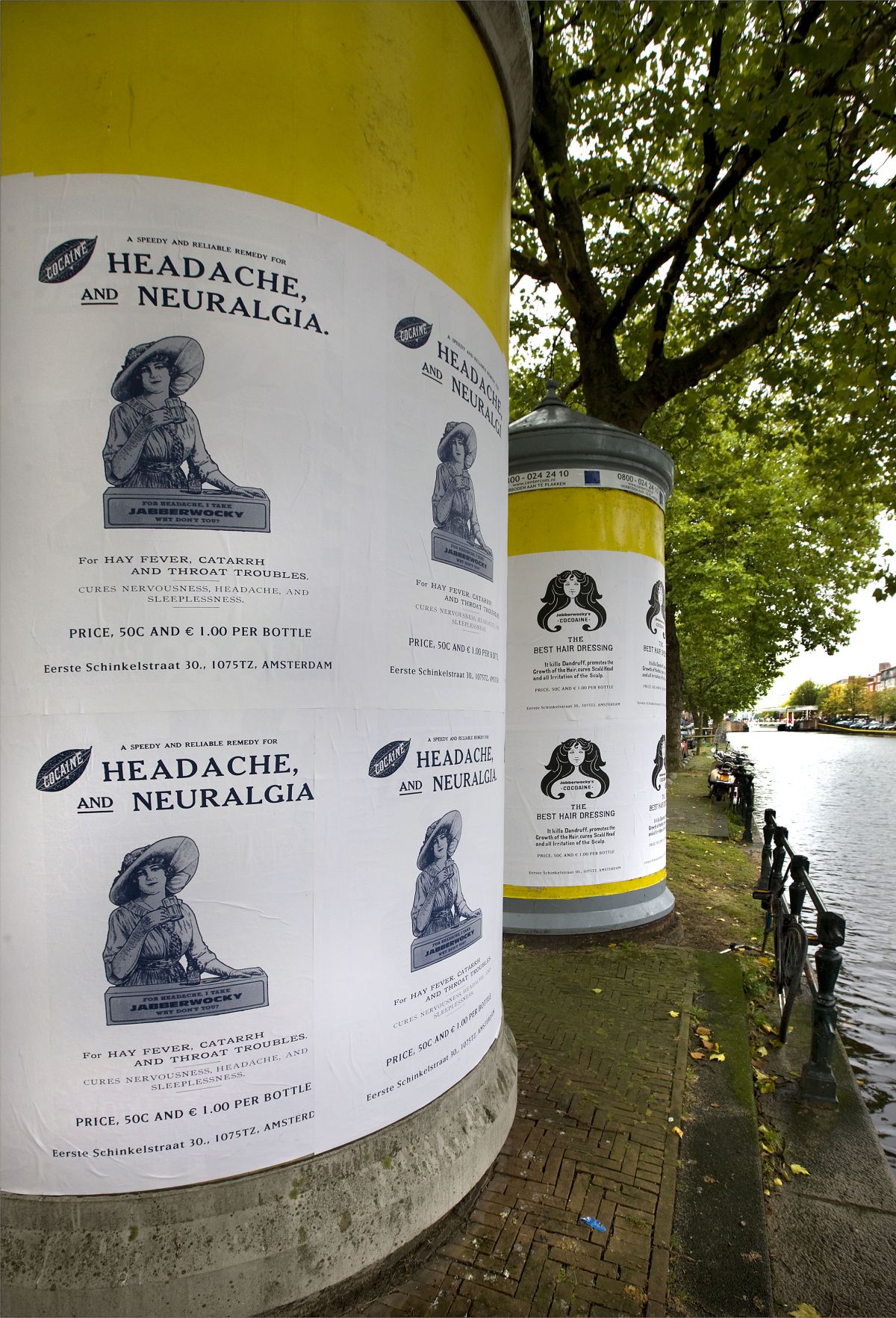
Go Eun Im (KO) NEDERLANDSCHE COCAÏNEFABRIEK, 2011
Mixed media installation,
Schinkelkade opposite #20, Amsterdam
For her contribution to the Kunst aan de Schinkel project, the South Korean artist Go Eun Im was inspired by the Dutch Cocaine Factory [Nederlandsche Cocaïnefabriek]. The early 20th century factory, situated on the corner of the Eerste Schinkelstraat and the Schinkelkade, produced cocaine for medicinal, military and recreational purposes from coca plants cultivated in the Dutch East Indies. Even though the factory’s activities were not made public knowledge, it had managed to develop into the world’s largest factory by 1910. Not long afterwards, the factory was relocated to accommodate its explosive growth and enable further expansion. Im is fascinated that there was once an official factory in Amsterdam that produced, what are now, prohibited drugs. Few people living in Amsterdam and in the Schinkel area are aware of these historical facts. The artist has carried out thorough research into stories and images from historic publications and archives, which have formed the source for her project for Kunst aan de Schinkel. By playing with the image in communication, representation and compilation of objects, Go Eun Im aims to revive the history of the factory and to put visitors on the wrong track. The information from the past will certainly be tested against today’s view.
Go Eun Im [Sangchen, 1981] studied at the Yonsei University, Graduate School of Communication and Art [MFA in Media Art] in Seoul, and was artist in residence at the Rijksakademie voor Beeldende Kunsten in Amsterdam in 2008/2009. Go Eun Im lives in Amsterdam and exhibits in the Netherlands and abroad. In 2010, she won the public award: The NEW MEDIA AWARD of the Liedts-Meesen Foundation, Update III, in Ghent, Belgium.
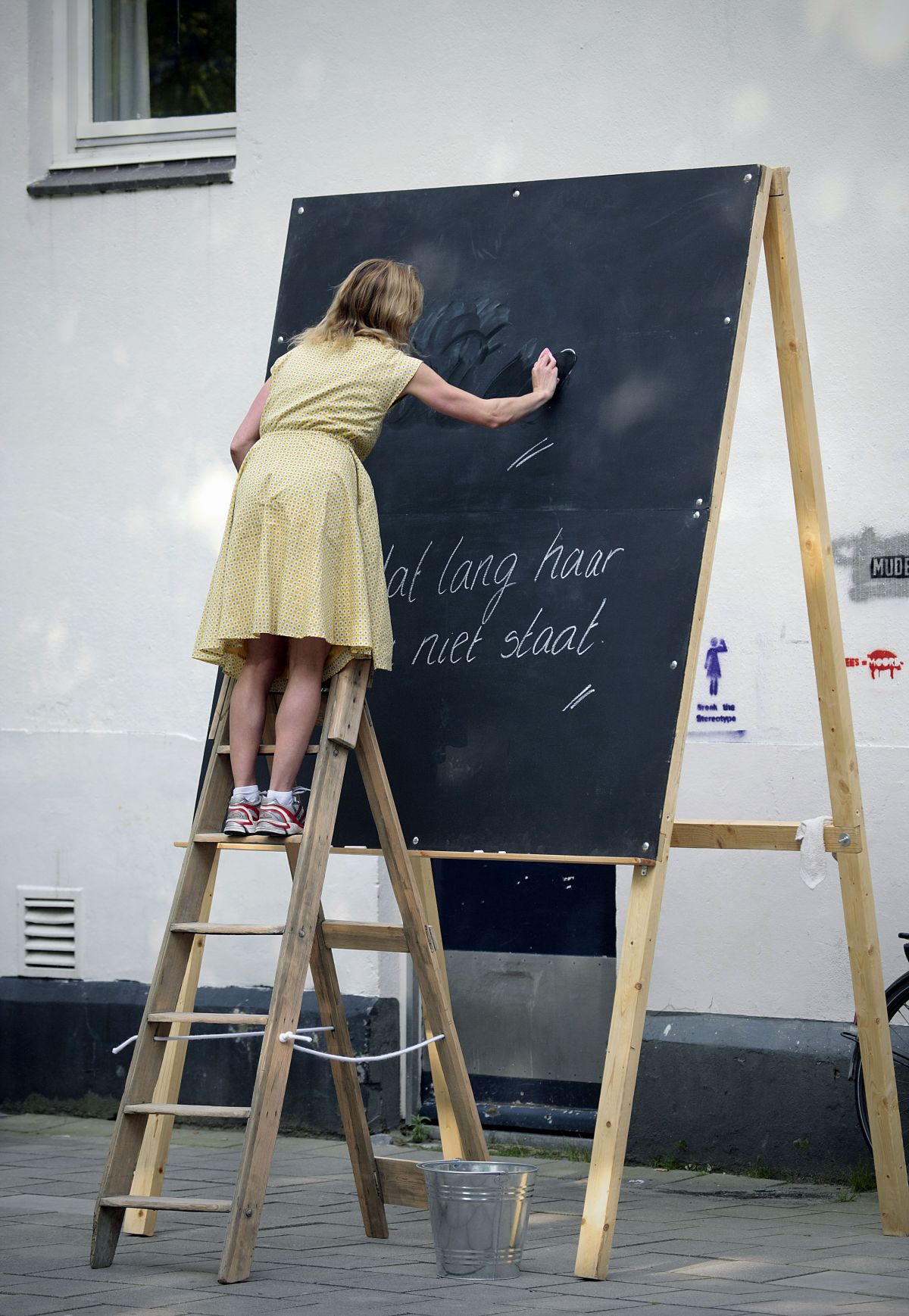
Helen Morse Palmer (UK) You know not what you ask, 2011
Performance,
Schinkelkade/Tweede Schinkelstraat, Amsterdam
In her work Helen Morse Palmer studies the use of theatricality in art. She hereby uses important theatrical elements such as costumes, scripts, sets, sound, music, movement, light, and finds original ways to use these elements in daily life. With her performance art she studies and plays with the established meanings of items such as
the wedding dress and the red-dot sticker on works of art.
The artist used the history and residents of Amsterdam’s Schinkel neighbourhood as a starting point for her performance ‘You Know Not What You Ask’, for the Kunst aan de Schinkel project. There used to be an inn on the Schinkel quay in the 15th century and to attract more customers, the innkeeper had installed a sign on his inn with the text ‘te Vraghe’, which means as much as ‘this is where you can ask questions’. Inspired by these historical facts, Morse Palmer’s project uses questions and answers that were thought up by the local residents during her workshops. As in the 15th century, Morse Palmer will place a sign alongside the Schinkel on which she will repeatedly write new questions, one question at a time. Then, running to the other side of the water, she will find a written answer to her question and will bring it back to her starting point. Every new question will demand a new journey. The questions and answers will be matched at random. The artist only speaks English and is therefore completely unaware of what she will be writing. With her live performance, the artist shows that miscommunication in daily life can be moving, surprising and entertaining.
Helen Morse Palmer [Exeter, 1977] studied Fine Art at Reading University and Central Saint Martins in London. She works, amongst other things, as a Community Artist in London and Epping and is also associated with the Station House Opera and the Live Art Garden Initiative, as creator and performer. She recently made work for Journey to the Podium in collaboration with Team GB Athlete James Huckle for the ‘2012 Olympic exhibition’.
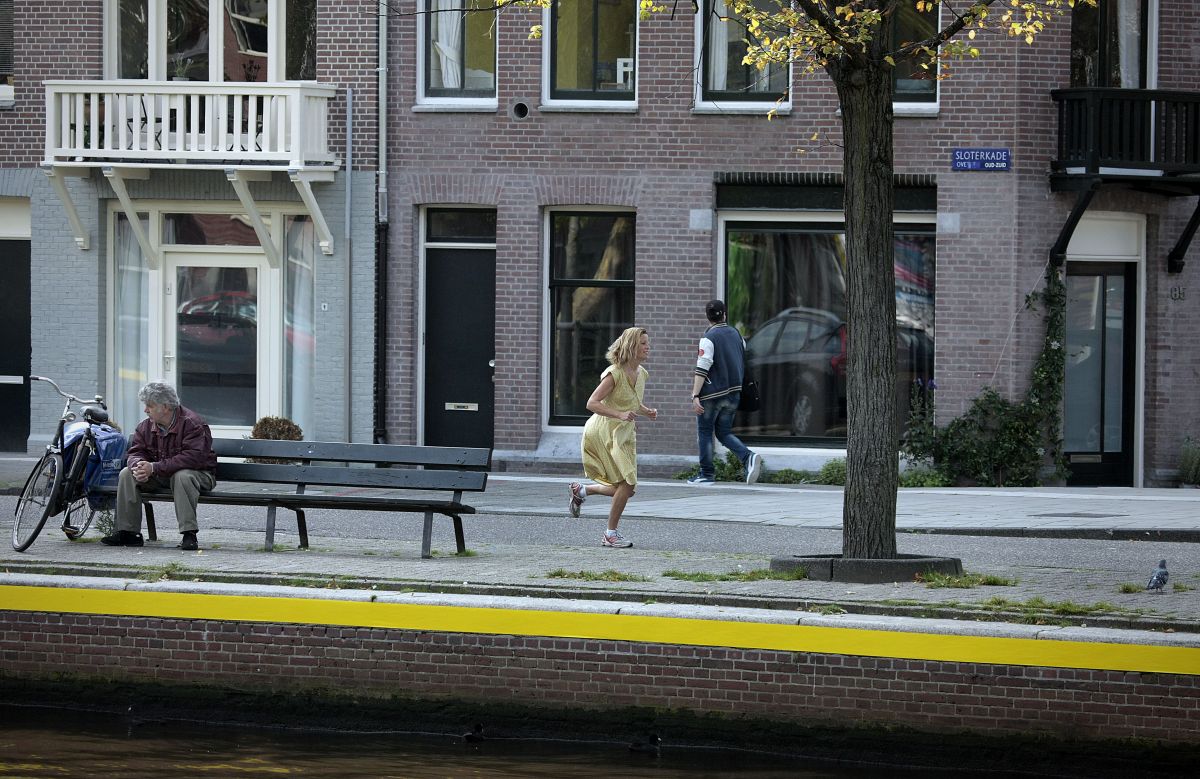
Helen Morse Palmer (UK) You know not what you ask, 2011
Performance,
Schinkelkade/Tweede Schinkelstraat, Amsterdam
In her work Helen Morse Palmer studies the use of theatricality in art. She hereby uses important theatrical elements such as costumes, scripts, sets, sound, music, movement, light, and finds original ways to use these elements in daily life. With her performance art she studies and plays with the established meanings of items such as
the wedding dress and the red-dot sticker on works of art.
The artist used the history and residents of Amsterdam’s Schinkel neighbourhood as a starting point for her performance ‘You Know Not What You Ask’, for the Kunst aan de Schinkel project. There used to be an inn on the Schinkel quay in the 15th century and to attract more customers, the innkeeper had installed a sign on his inn with the text ‘te Vraghe’, which means as much as ‘this is where you can ask questions’. Inspired by these historical facts, Morse Palmer’s project uses questions and answers that were thought up by the local residents during her workshops. As in the 15th century, Morse Palmer will place a sign alongside the Schinkel on which she will repeatedly write new questions, one question at a time. Then, running to the other side of the water, she will find a written answer to her question and will bring it back to her starting point. Every new question will demand a new journey. The questions and answers will be matched at random. The artist only speaks English and is therefore completely unaware of what she will be writing. With her live performance, the artist shows that miscommunication in daily life can be moving, surprising and entertaining.
Helen Morse Palmer [Exeter, 1977] studied Fine Art at Reading University and Central Saint Martins in London. She works, amongst other things, as a Community Artist in London and Epping and is also associated with the Station House Opera and the Live Art Garden Initiative, as creator and performer. She recently made work for Journey to the Podium in collaboration with Team GB Athlete James Huckle for the ‘2012 Olympic exhibition’.
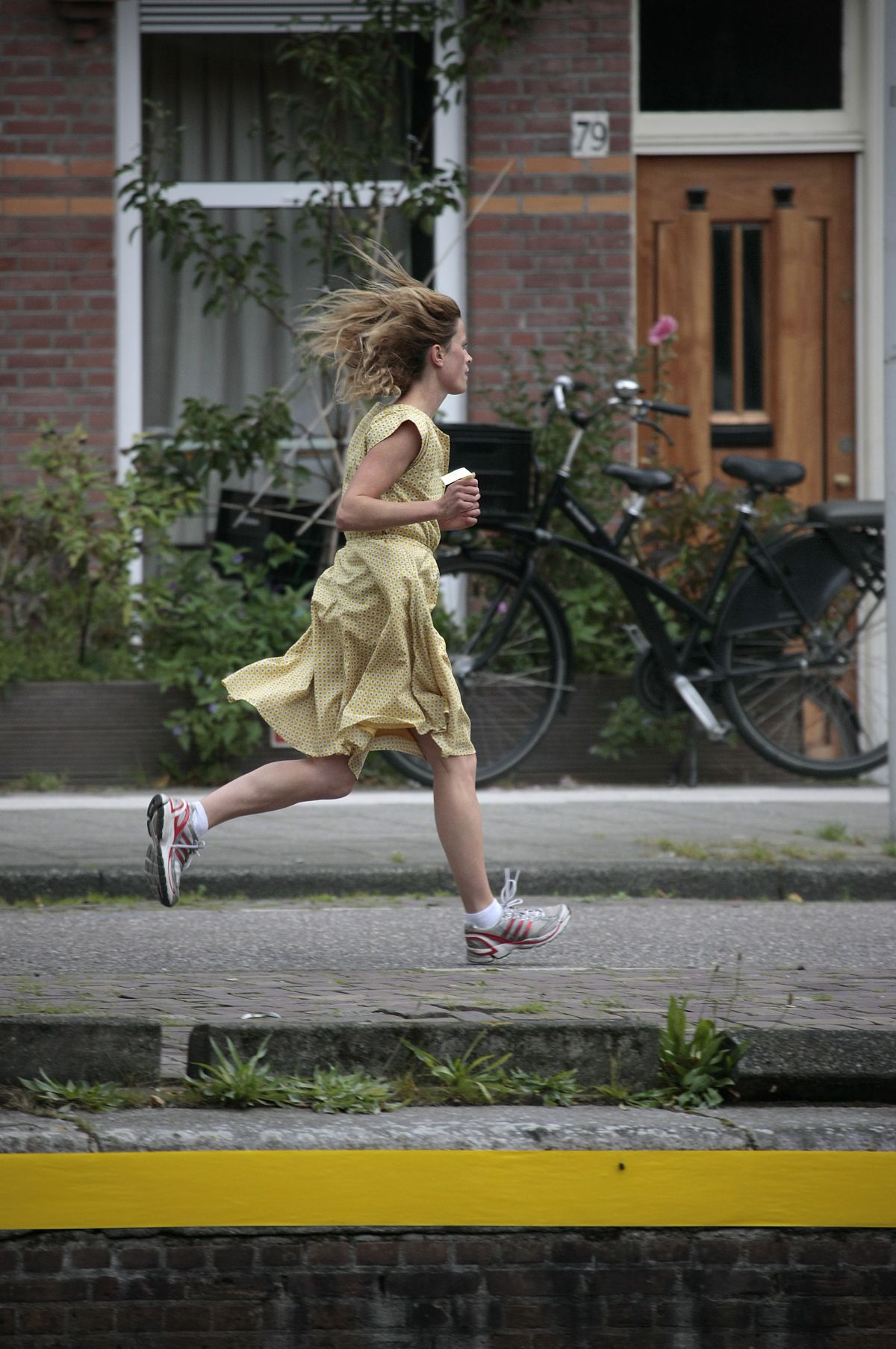
Helen Morse Palmer (UK) You know not what you ask, 2011
Performance,
Schinkelkade/Tweede Schinkelstraat, Amsterdam
In her work Helen Morse Palmer studies the use of theatricality in art. She hereby uses important theatrical elements such as costumes, scripts, sets, sound, music, movement, light, and finds original ways to use these elements in daily life. With her performance art she studies and plays with the established meanings of items such as
the wedding dress and the red-dot sticker on works of art.
The artist used the history and residents of Amsterdam’s Schinkel neighbourhood as a starting point for her performance ‘You Know Not What You Ask’, for the Kunst aan de Schinkel project. There used to be an inn on the Schinkel quay in the 15th century and to attract more customers, the innkeeper had installed a sign on his inn with the text ‘te Vraghe’, which means as much as ‘this is where you can ask questions’. Inspired by these historical facts, Morse Palmer’s project uses questions and answers that were thought up by the local residents during her workshops. As in the 15th century, Morse Palmer will place a sign alongside the Schinkel on which she will repeatedly write new questions, one question at a time. Then, running to the other side of the water, she will find a written answer to her question and will bring it back to her starting point. Every new question will demand a new journey. The questions and answers will be matched at random. The artist only speaks English and is therefore completely unaware of what she will be writing. With her live performance, the artist shows that miscommunication in daily life can be moving, surprising and entertaining.
Helen Morse Palmer [Exeter, 1977] studied Fine Art at Reading University and Central Saint Martins in London. She works, amongst other things, as a Community Artist in London and Epping and is also associated with the Station House Opera and the Live Art Garden Initiative, as creator and performer. She recently made work for Journey to the Podium in collaboration with Team GB Athlete James Huckle for the ‘2012 Olympic exhibition’.
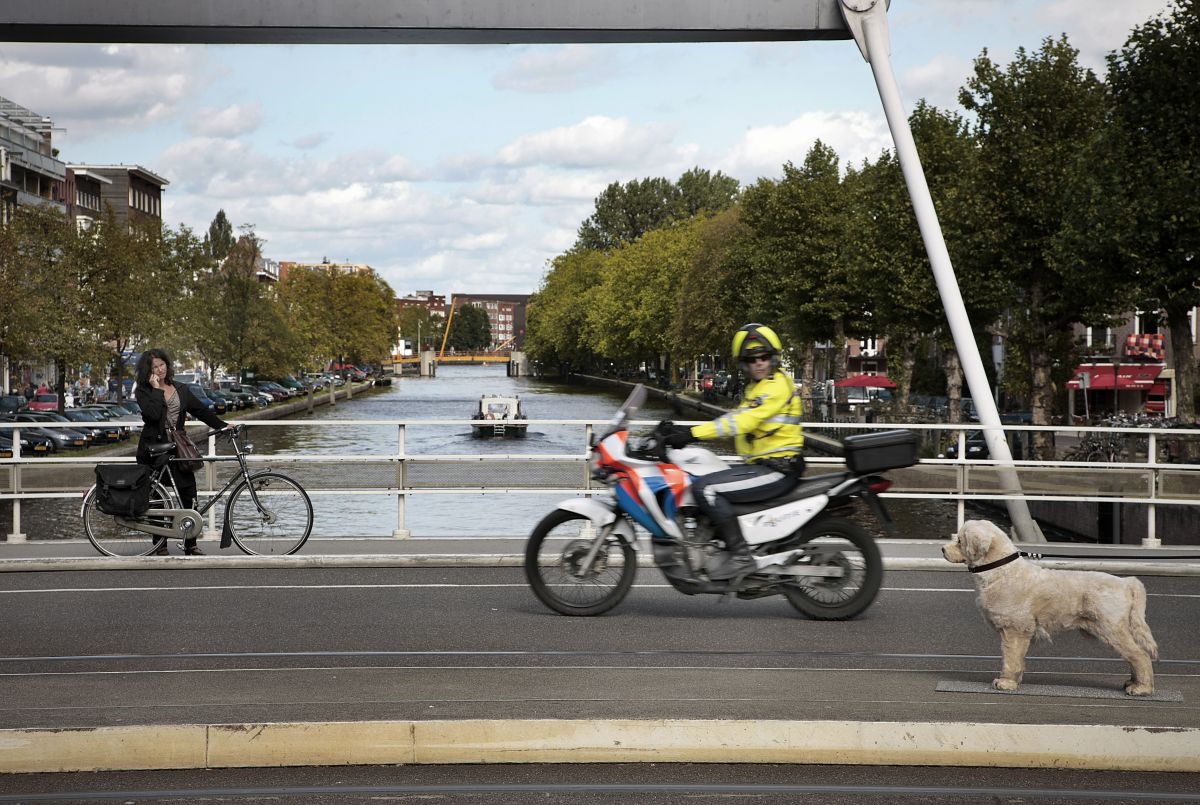
Hester Oerlemans (NL) BLIJF!, 2011
polyester, artificial fur, iron, rope, belt, golden retriever, life size,
Zeilbrug, Amsterdam
Hester Oerlemans started as a painter, but after studying at the academy in Arnhem she started to look for new works of art that would enable her to make more direct contact with the public. She increasingly focused on projects and installations in the public space. In her work, the artist is concerned with reality and particularly with how we experience it. It is a mixture of poetry and absurdity, sharpening perception. An example of this is her work ‘The Floating Carpet’, which she installed at the PGGM in Zeist in May 2011. The enormous carpet floats 40cm above the ground, which occasionally moves half a meter to the right or to the left, whenever someone sits on it.
For the Kunst aan de Schinkel project, Oerlemans has placed the installation ‘BLIJF!’ A life-size cuddly dog tied, on a tight leash, to the tram pole on the Zeilbrug. The bridge opens but the dog stays put. With ‘BLIJF!’ Oerlemans has created an image that is both familiar and absurd. Her intervention has a very narrative connotation and offers observers a visual starting point for their own fantasy.
Hester Oerlemans [Schijndel, 1961] lives and works in Berlin. She studied at ArtEZ in Arnhem. She exhibits on an international level and has realised a range of projects in public spaces. Her work is represented in various Dutch corporate collections and museums.
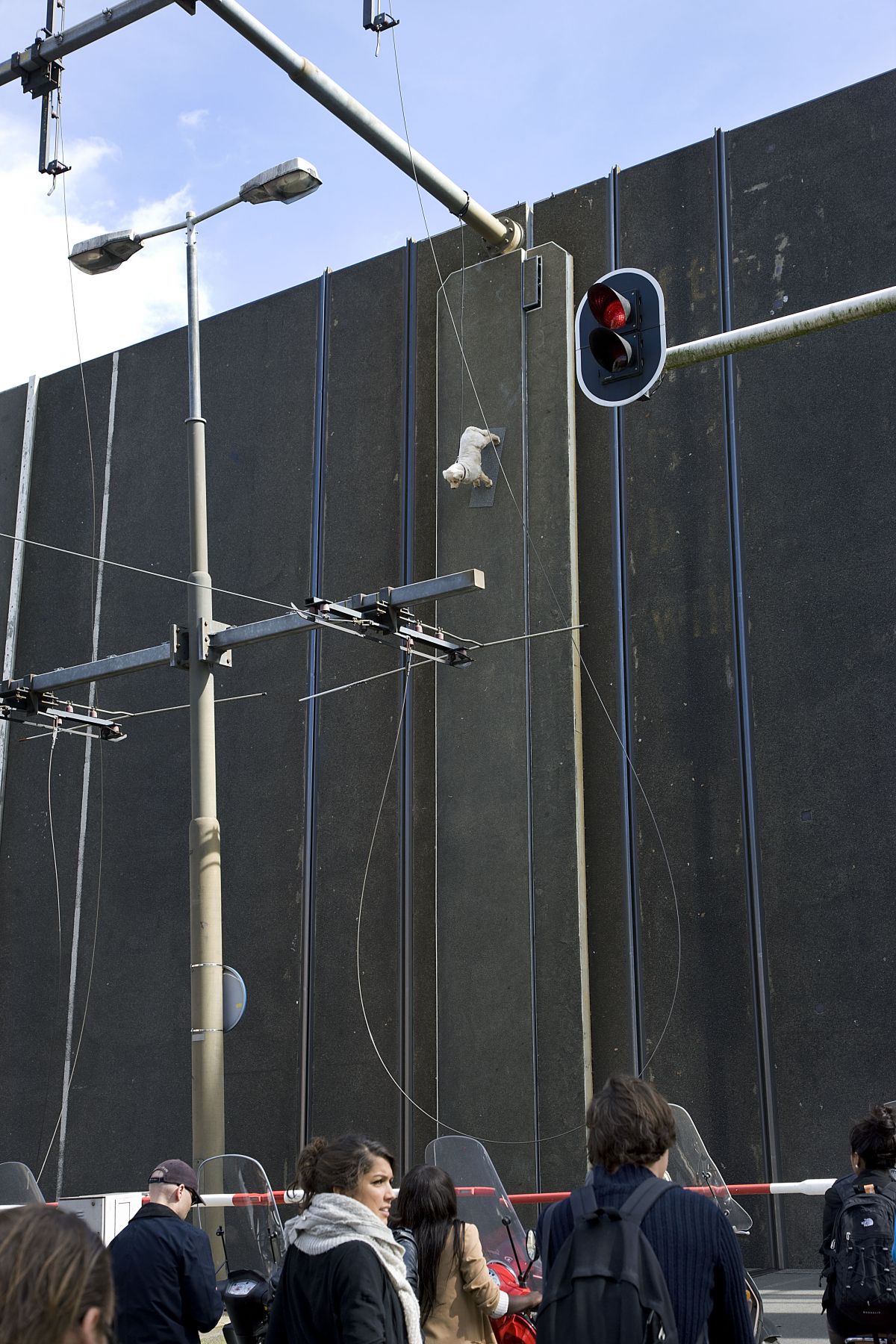
Hester Oerlemans (NL) BLIJF!, 2011
polyester, artificial fur, iron, rope, belt, golden retriever, life size,
Zeilbrug, Amsterdam
Hester Oerlemans started as a painter, but after studying at the academy in Arnhem she started to look for new works of art that would enable her to make more direct contact with the public. She increasingly focused on projects and installations in the public space. In her work, the artist is concerned with reality and particularly with how we experience it. It is a mixture of poetry and absurdity, sharpening perception. An example of this is her work ‘The Floating Carpet’, which she installed at the PGGM in Zeist in May 2011. The enormous carpet floats 40cm above the ground, which occasionally moves half a meter to the right or to the left, whenever someone sits on it.
For the Kunst aan de Schinkel project, Oerlemans has placed the installation ‘BLIJF!’ A life-size cuddly dog tied, on a tight leash, to the tram pole on the Zeilbrug. The bridge opens but the dog stays put. With ‘BLIJF!’ Oerlemans has created an image that is both familiar and absurd. Her intervention has a very narrative connotation and offers observers a visual starting point for their own fantasy.
Hester Oerlemans [Schijndel, 1961] lives and works in Berlin. She studied at ArtEZ in Arnhem. She exhibits on an international level and has realised a range of projects in public spaces. Her work is represented in various Dutch corporate collections and museums.
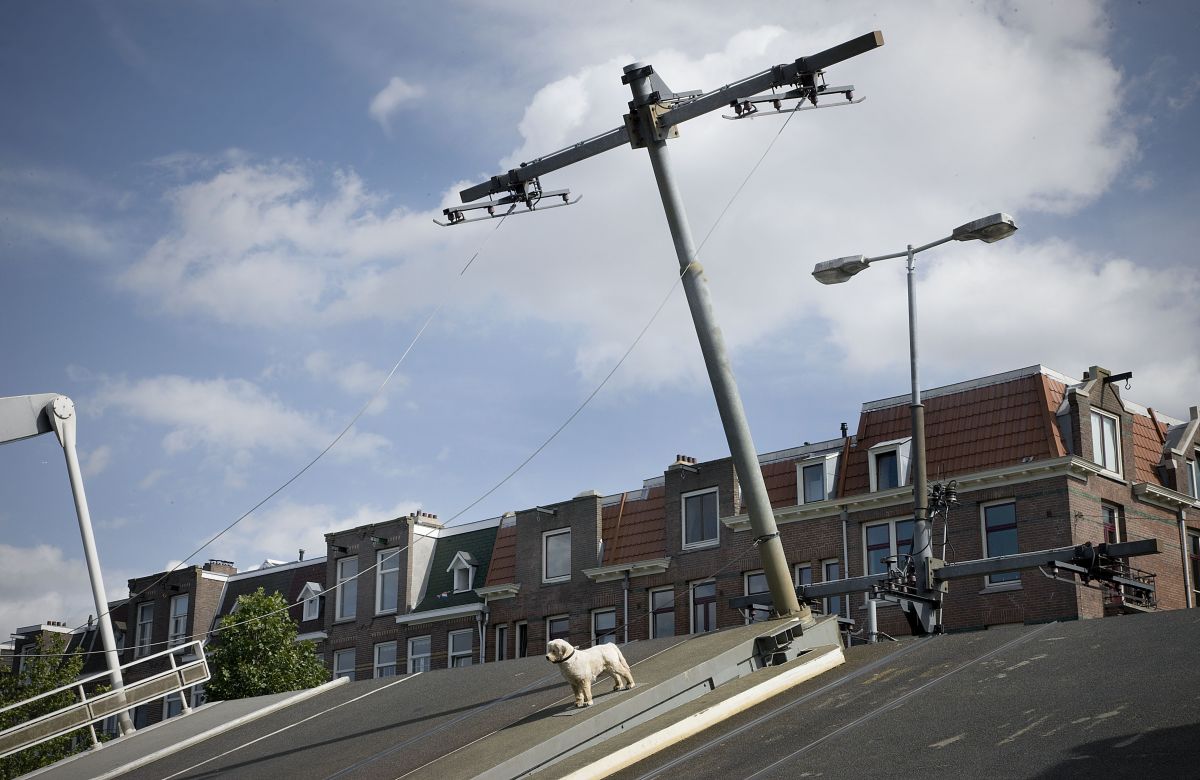
Hester Oerlemans (NL) BLIJF!, 2011
polyester, artificial fur, iron, rope, belt, golden retriever, life size,
Zeilbrug, Amsterdam
Hester Oerlemans started as a painter, but after studying at the academy in Arnhem she started to look for new works of art that would enable her to make more direct contact with the public. She increasingly focused on projects and installations in the public space. In her work, the artist is concerned with reality and particularly with how we experience it. It is a mixture of poetry and absurdity, sharpening perception. An example of this is her work ‘The Floating Carpet’, which she installed at the PGGM in Zeist in May 2011. The enormous carpet floats 40cm above the ground, which occasionally moves half a meter to the right or to the left, whenever someone sits on it.
For the Kunst aan de Schinkel project, Oerlemans has placed the installation ‘BLIJF!’ A life-size cuddly dog tied, on a tight leash, to the tram pole on the Zeilbrug. The bridge opens but the dog stays put. With ‘BLIJF!’ Oerlemans has created an image that is both familiar and absurd. Her intervention has a very narrative connotation and offers observers a visual starting point for their own fantasy.
Hester Oerlemans [Schijndel, 1961] lives and works in Berlin. She studied at ArtEZ in Arnhem. She exhibits on an international level and has realised a range of projects in public spaces. Her work is represented in various Dutch corporate collections and museums.
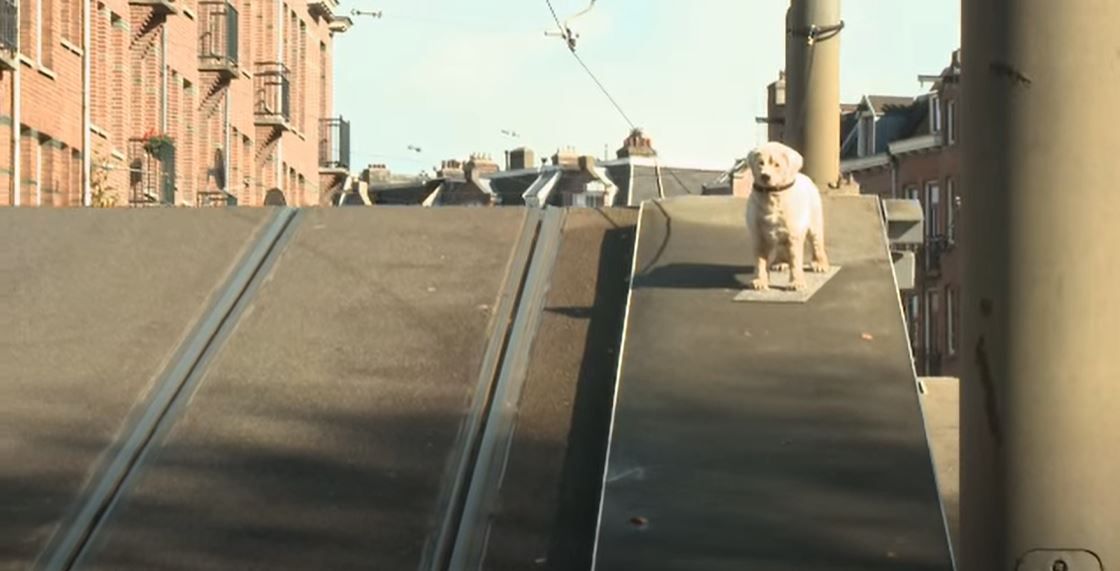
Hester Oerlemans (NL) BLIJF!, 2011
polyester, artificial fur, iron, rope, belt, golden retriever, life size,
Zeilbrug, Amsterdam
Hester Oerlemans started as a painter, but after studying at the academy in Arnhem she started to look for new works of art that would enable her to make more direct contact with the public. She increasingly focused on projects and installations in the public space. In her work, the artist is concerned with reality and particularly with how we experience it. It is a mixture of poetry and absurdity, sharpening perception. An example of this is her work ‘The Floating Carpet’, which she installed at the PGGM in Zeist in May 2011. The enormous carpet floats 40cm above the ground, which occasionally moves half a meter to the right or to the left, whenever someone sits on it.
For the Kunst aan de Schinkel project, Oerlemans has placed the installation ‘BLIJF!’ A life-size cuddly dog tied, on a tight leash, to the tram pole on the Zeilbrug. The bridge opens but the dog stays put. With ‘BLIJF!’ Oerlemans has created an image that is both familiar and absurd. Her intervention has a very narrative connotation and offers observers a visual starting point for their own fantasy.
Hester Oerlemans [Schijndel, 1961] lives and works in Berlin. She studied at ArtEZ in Arnhem. She exhibits on an international level and has realised a range of projects in public spaces. Her work is represented in various Dutch corporate collections and museums.
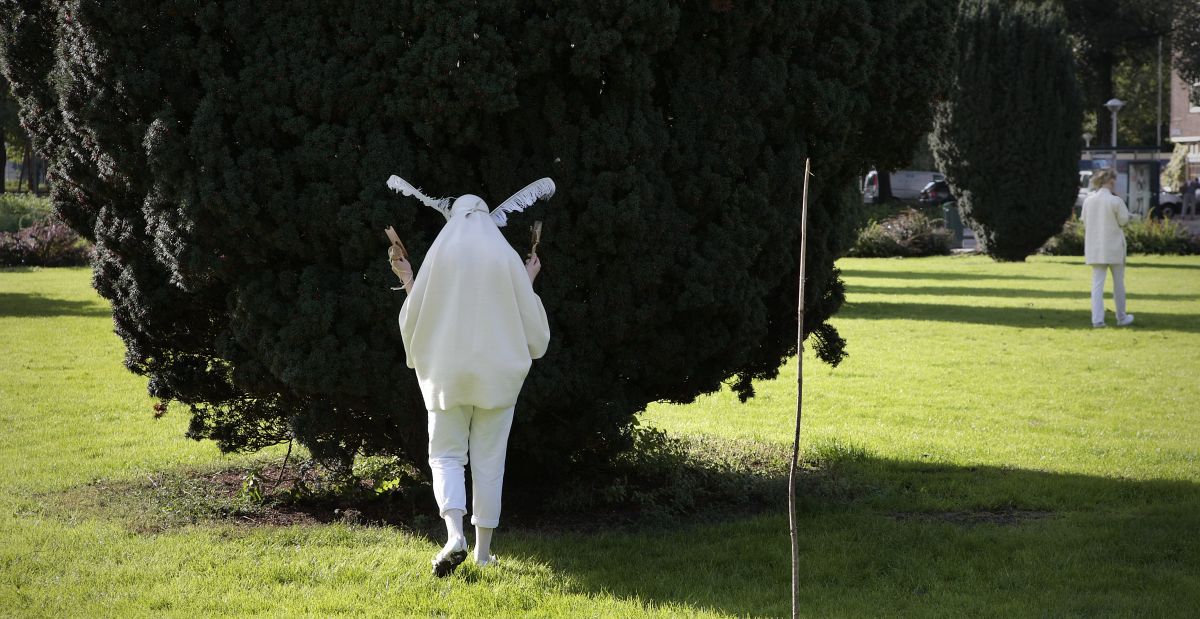
Jasper Griepink (NL) The plant doctor is in town, 2011
Performance,
Theophile de Bockpark, Amsterdam
Jasper Griepink is of the opinion that human awareness is based on cooperation, adaptability and patient growth. With his study into natural phenomena he aims to get in touch with a way of life, which he perceives as ‘original’, contrary to Darwin’s ‘survival of the fittest’. During the summer of 2011, he travelled as a plant doctor through the Schinkel neighbourhood. As part of the Kunst aan de Schinkel project, Griepink made door-to-door contact with very specific neighbourhood residents, namely the houseplants. With ‘The plant doctor is in town’ the artist tries to make the local residents more aware of their own surroundings, whilst studying the relationship between people and ‘domesticated’ nature.
Griepink has planned a ceremonial event in September for the houseplants in this district. In a performance, energy will be transferred to the plants, through means of ‘increased awareness’, gained by the Doctor himself and that of the residents. This ode to the houseplants will take place in a small park on the Theophile de Bockstraat in south Amsterdam. According to Griepink, the relationship between a resident and his or her houseplant can be directly translated to the bond between mankind and
nature at a large. With ‘The plant doctor is in town’ the residents’ influence on nature is made much more accessible. The plant doctor will also be available to act out small performances in the homes of the locals during the Kunst aan de Schinkel event.
Jasper Griepink [Eindhoven, 1988] graduated at the Utrecht School of the Arts [HKU] cum laude in 2010, where he also won the Jan-Zumbrink Award. This year he is continuing his study at the Piet Zwart Institute in Rotterdam. Griepink lives and works in Amsterdam.
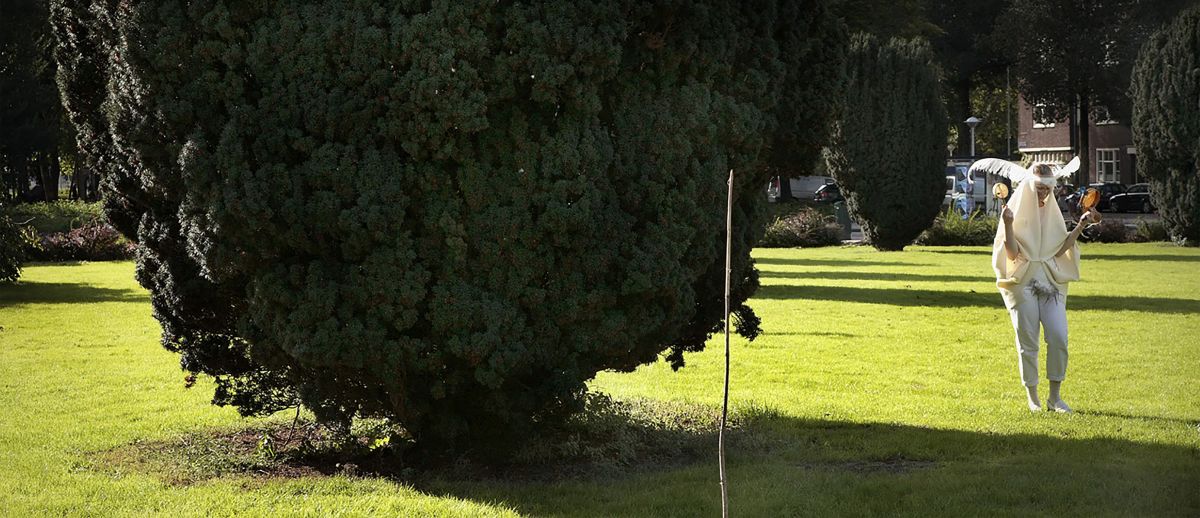
Jasper Griepink (NL) The plant doctor is in town, 2011
Performance,
Theophile de Bockpark, Amsterdam
Jasper Griepink is of the opinion that human awareness is based on cooperation, adaptability and patient growth. With his study into natural phenomena he aims to get in touch with a way of life, which he perceives as ‘original’, contrary to Darwin’s ‘survival of the fittest’. During the summer of 2011, he travelled as a plant doctor through the Schinkel neighbourhood. As part of the Kunst aan de Schinkel project, Griepink made door-to-door contact with very specific neighbourhood residents, namely the houseplants. With ‘The plant doctor is in town’ the artist tries to make the local residents more aware of their own surroundings, whilst studying the relationship between people and ‘domesticated’ nature.
Griepink has planned a ceremonial event in September for the houseplants in this district. In a performance, energy will be transferred to the plants, through means of ‘increased awareness’, gained by the Doctor himself and that of the residents. This ode to the houseplants will take place in a small park on the Theophile de Bockstraat in south Amsterdam. According to Griepink, the relationship between a resident and his or her houseplant can be directly translated to the bond between mankind and
nature at a large. With ‘The plant doctor is in town’ the residents’ influence on nature is made much more accessible. The plant doctor will also be available to act out small performances in the homes of the locals during the Kunst aan de Schinkel event.
Jasper Griepink [Eindhoven, 1988] graduated at the Utrecht School of the Arts [HKU] cum laude in 2010, where he also won the Jan-Zumbrink Award. This year he is continuing his study at the Piet Zwart Institute in Rotterdam. Griepink lives and works in Amsterdam.
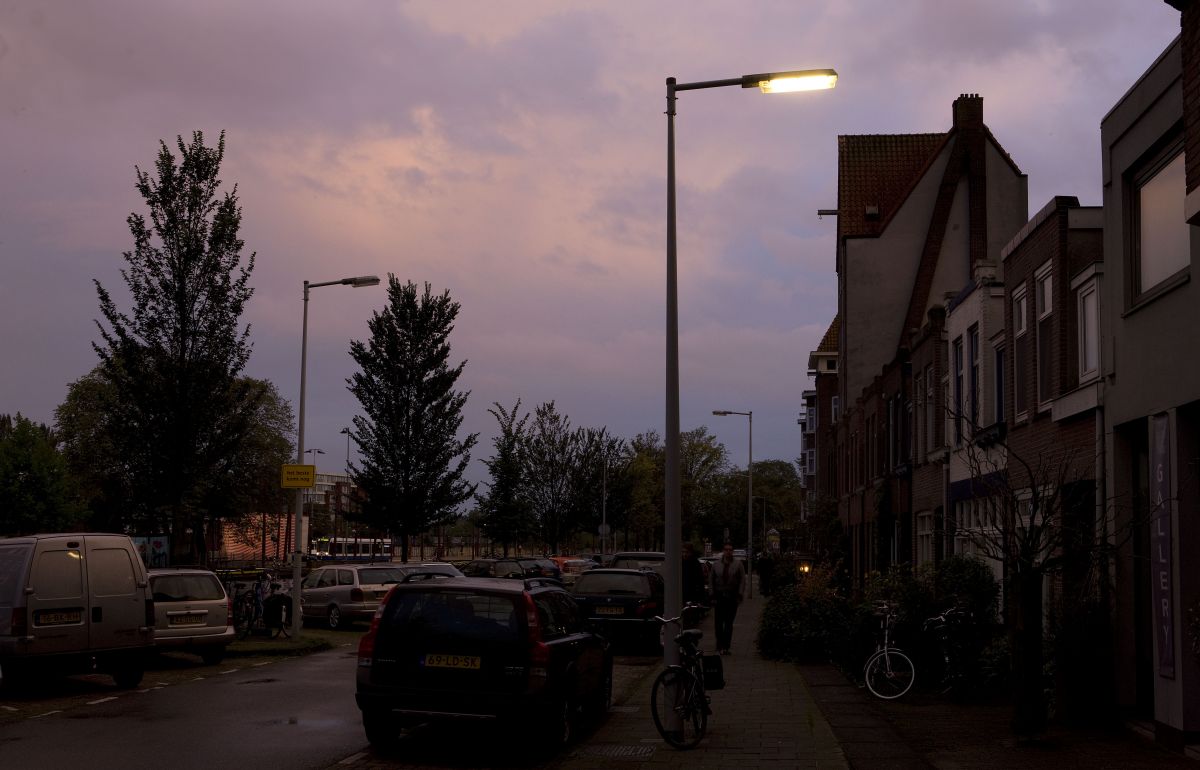
Jasper van den Brink (NL) The Switch, 2011
Lamppost, monitor with video,
Sloterkade 171, Amsterdam
Jasper van den Brink uses the camera to discover new ways of looking at the world. For many years the artist allowed cameras to do seemingly impossible things. He secured them to moving objects, such as cement trucks, the sails of a windmill and had even hidden one in a ball. He disconnects the camera from the eye, and in doing so places the observer in situations, which don’t normally appear in daily life. His work leaves a refreshingly playful impression and appeals to the viewer’s imagination. He makes installations as well as video art.
For the Kunst aan de Schinkel project, the artist placed a lamppost directly in front of the Soledad Senlle Gallery of which the light switches on and off mysteriously. This site-specific installation blurs fiction and reality, which seamlessly intertwine.
Jasper van den Brink [Stompwijk, 1968] studied at the Gerrit Rietveld Academy and the Rijksakademie van Beeldende Kunsten in Amsterdam. He has exhibited internationally at institutions such as the AD&A Gallery in Osaka, Japan, the Third Space Gallery in Saint John, Canada, and Manifesta 4 in Frankfurt. In 2002 he won the runner-up prize of the Prix de Rome. In 2005 he was artist-in-residence at IASPIS [International Artists Studio Programm Stockholm] and in 2007 at IAMAS [Institute
of Advanced Media Arts and Sciences] in Ogaki, Japan.
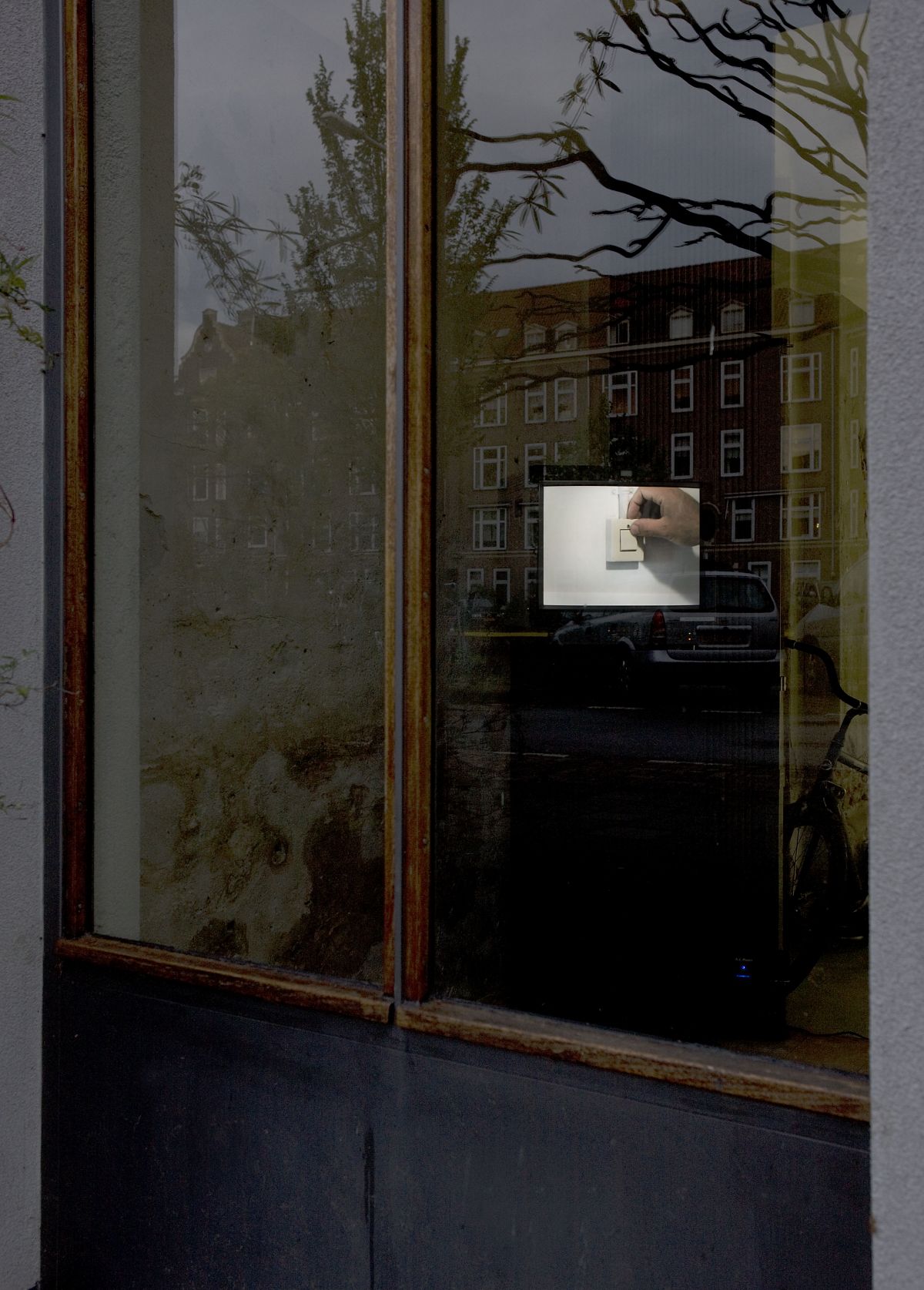
Jasper van den Brink (NL) The Switch, 2011
Lamppost, monitor with video,
Sloterkade 171, Amsterdam
Jasper van den Brink uses the camera to discover new ways of looking at the world. For many years the artist allowed cameras to do seemingly impossible things. He secured them to moving objects, such as cement trucks, the sails of a windmill and had even hidden one in a ball. He disconnects the camera from the eye, and in doing so places the observer in situations, which don’t normally appear in daily life. His work leaves a refreshingly playful impression and appeals to the viewer’s imagination. He makes installations as well as video art.
For the Kunst aan de Schinkel project, the artist placed a lamppost directly in front of the Soledad Senlle Gallery of which the light switches on and off mysteriously. This site-specific installation blurs fiction and reality, which seamlessly intertwine.
Jasper van den Brink [Stompwijk, 1968] studied at the Gerrit Rietveld Academy and the Rijksakademie van Beeldende Kunsten in Amsterdam. He has exhibited internationally at institutions such as the AD&A Gallery in Osaka, Japan, the Third Space Gallery in Saint John, Canada, and Manifesta 4 in Frankfurt. In 2002 he won the runner-up prize of the Prix de Rome. In 2005 he was artist-in-residence at IASPIS [International Artists Studio Programm Stockholm] and in 2007 at IAMAS [Institute
of Advanced Media Arts and Sciences] in Ogaki, Japan.
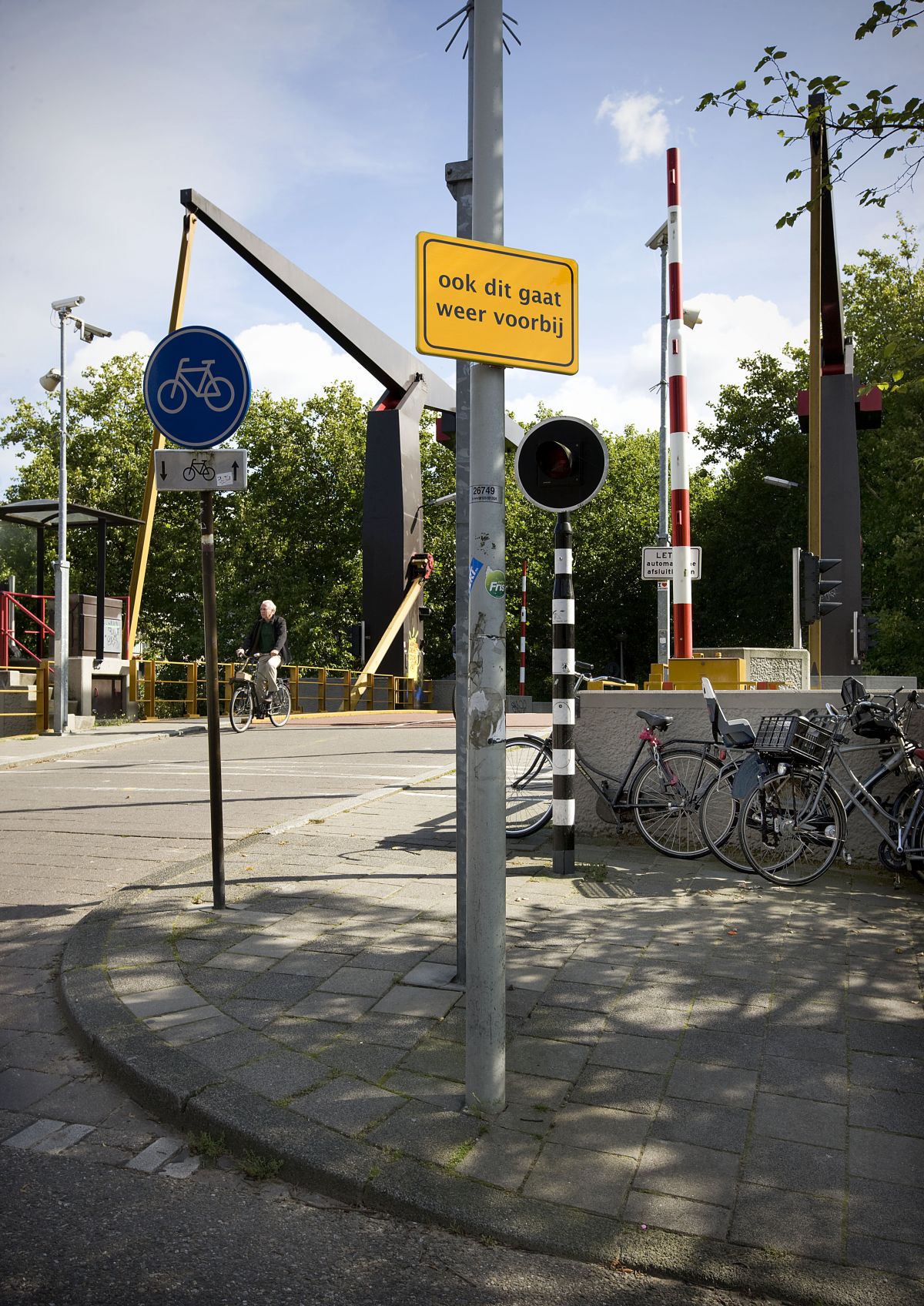
Joanneke Meester (NL) Signs, 2011
Mixed Media,
Various locations along the Schinkel, Amsterdam
Joanneke Meester’s recent text-based works are fragments, literally cut outs, of her thoughts, emotions, inspirations and actions with regards to the world she lives in. For the Kunst aan de Schinkel project, Meester has produced seven yellow traffic signs, entitled ‘Signs’. They feature inspirational and relativistic texts, which can be interpreted in a number of ways in relation to the local residents, visitors, neighbourhood and the temporary art manifestation. The yellow signs, which are originally used to direct traffic and indicate diversions, are given a whole new significance and, in combination with the context, various layers of meaning. They give direction in their own way, based on thought processes, imagination and reflection. The signs are placed at various locations along the art route.
Joanneke Meester [Purmerend, 1966] studied at the Hoge School voor de Kunsten and the Sandberg Institute in Amsterdam. She gained international fame with the pistol she made from her own skin. Her previous installations, sculptures and videos are the result of research into the subcutaneous violence, present in every human being. In her recent works she still addresses existential issues regarding violence, identity, daily life and imagination.
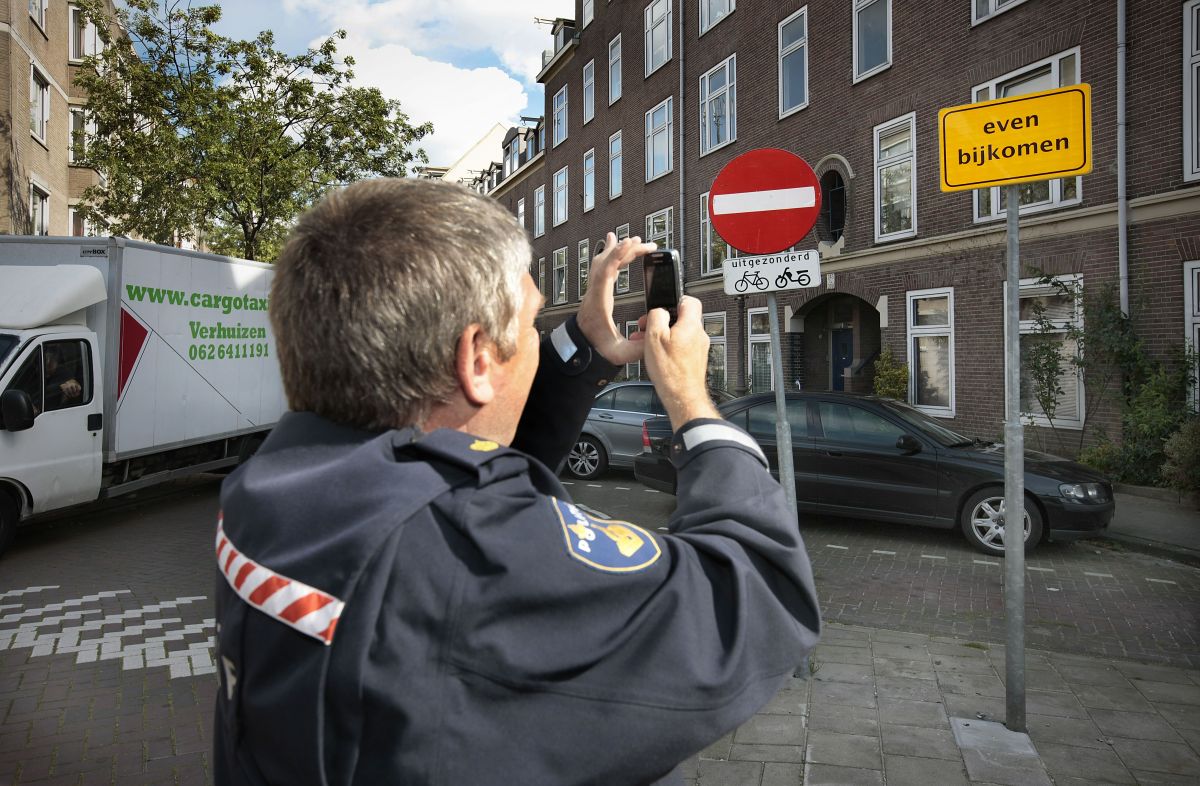
Joanneke Meester (NL) Signs, 2011
Mixed Media,
Various locations along the Schinkel, Amsterdam
Joanneke Meester’s recent text-based works are fragments, literally cut outs, of her thoughts, emotions, inspirations and actions with regards to the world she lives in. For the Kunst aan de Schinkel project, Meester has produced seven yellow traffic signs, entitled ‘Signs’. They feature inspirational and relativistic texts, which can be interpreted in a number of ways in relation to the local residents, visitors, neighbourhood and the temporary art manifestation. The yellow signs, which are originally used to direct traffic and indicate diversions, are given a whole new significance and, in combination with the context, various layers of meaning. They give direction in their own way, based on thought processes, imagination and reflection. The signs are placed at various locations along the art route.
Joanneke Meester [Purmerend, 1966] studied at the Hoge School voor de Kunsten and the Sandberg Institute in Amsterdam. She gained international fame with the pistol she made from her own skin. Her previous installations, sculptures and videos are the result of research into the subcutaneous violence, present in every human being. In her recent works she still addresses existential issues regarding violence, identity, daily life and imagination.
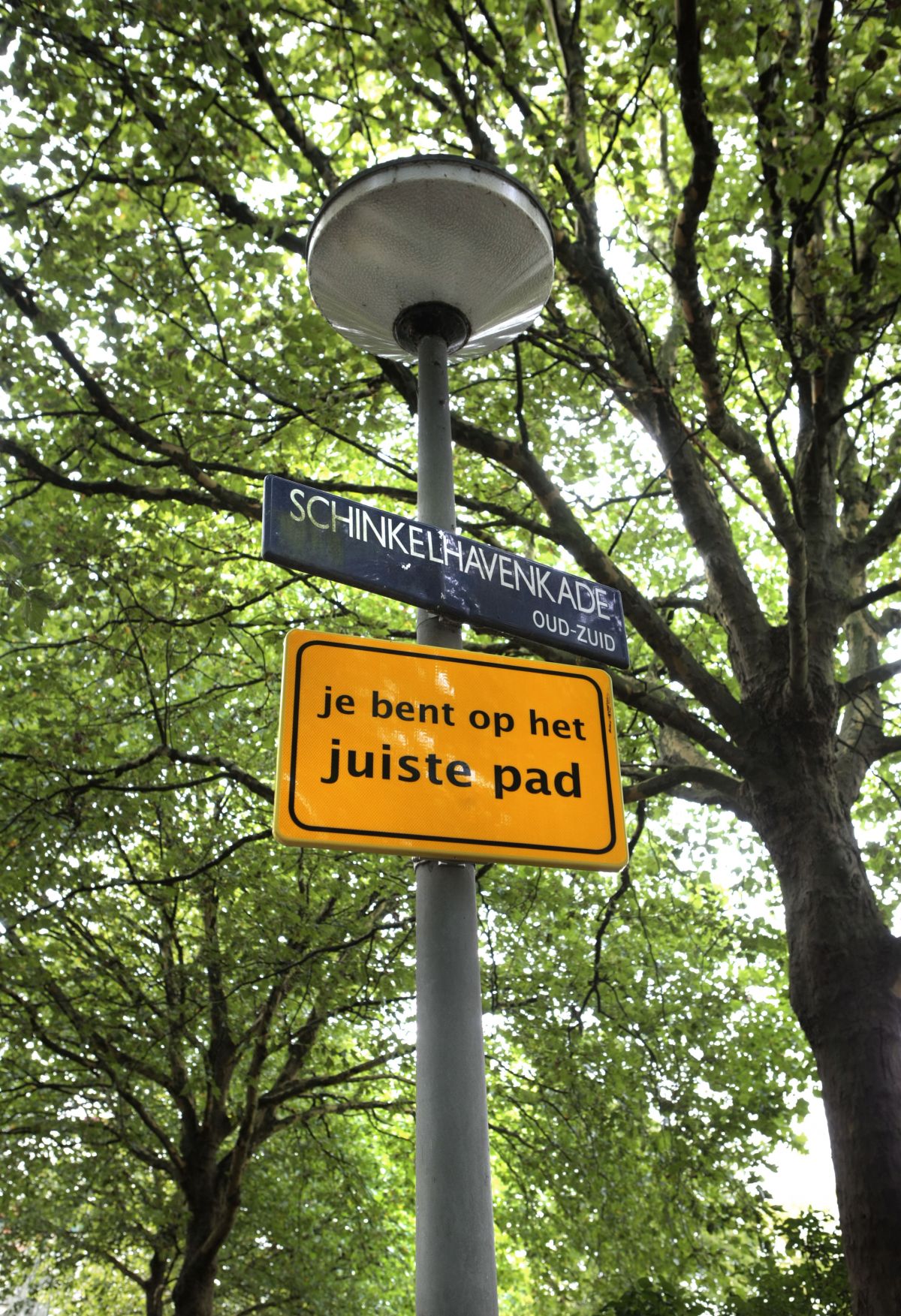
Joanneke Meester (NL) Signs, 2011
Mixed Media,
Various locations along the Schinkel, Amsterdam
Joanneke Meester’s recent text-based works are fragments, literally cut outs, of her thoughts, emotions, inspirations and actions with regards to the world she lives in. For the Kunst aan de Schinkel project, Meester has produced seven yellow traffic signs, entitled ‘Signs’. They feature inspirational and relativistic texts, which can be interpreted in a number of ways in relation to the local residents, visitors, neighbourhood and the temporary art manifestation. The yellow signs, which are originally used to direct traffic and indicate diversions, are given a whole new significance and, in combination with the context, various layers of meaning. They give direction in their own way, based on thought processes, imagination and reflection. The signs are placed at various locations along the art route.
Joanneke Meester [Purmerend, 1966] studied at the Hoge School voor de Kunsten and the Sandberg Institute in Amsterdam. She gained international fame with the pistol she made from her own skin. Her previous installations, sculptures and videos are the result of research into the subcutaneous violence, present in every human being. In her recent works she still addresses existential issues regarding violence, identity, daily life and imagination.
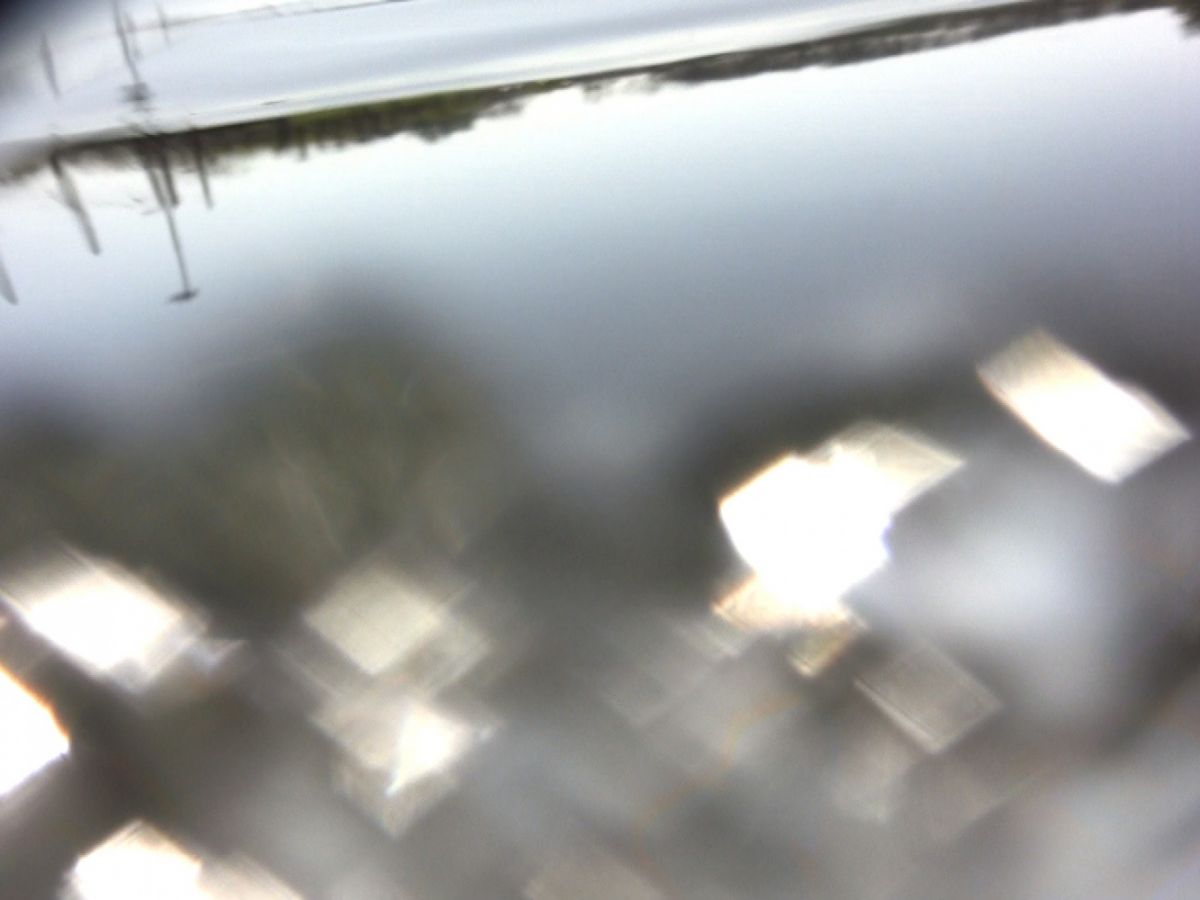
Margit Aba (NL) Water, 2011
Audio - video,
Schinkelkade 30, Amsterdam
Margit Aba makes photo and video works, as well as installations, in which she focuses on experiences and meanings within daily life. With her work she aims to stimulate the viewer into a focussed concentration by having them experience ‘things’ from up close. In doing so, she summons up a specific illusion, often in the form of a memory. What Aba is actually after is the overlapping of people’s shared memories. Yet, her focus goes further than the representation of reality. She offers a twist on the daily reality relating to time and space by playing with sentimentality, irony and vulnerability. In this way, she forces us to look at the world around us in a different manner.
Prompted by the notions of philosopher Michel de Certau, who sees the city as a social construction, Aba was inspired for Kunst aan de Schinkel by the movements and reflections of the river and daily life on the Schinkel. The daily interactions of the residents and the city are what define the city. In her video Aba zooms in on passing life, the stories and the anecdotes. Her audio/video installation, shown in a shop window at Schinkelkade 30, depicts the beauty of ‘the everyday’.
Margit Aba [The Hague, 1958] studied at the Gerrit Rietveld Academy as well as studying Philosophy and Political Science at the University of Amsterdam. She is affiliated with the Scenography Department of the Amsterdam School of Arts as a philosophy teacher and is the editor of the philosophical publisher Parrèsia. She has exhibited, amongst other places, at Huize Frankendael and W139 in Amsterdam and at Chelsea Market in New York.
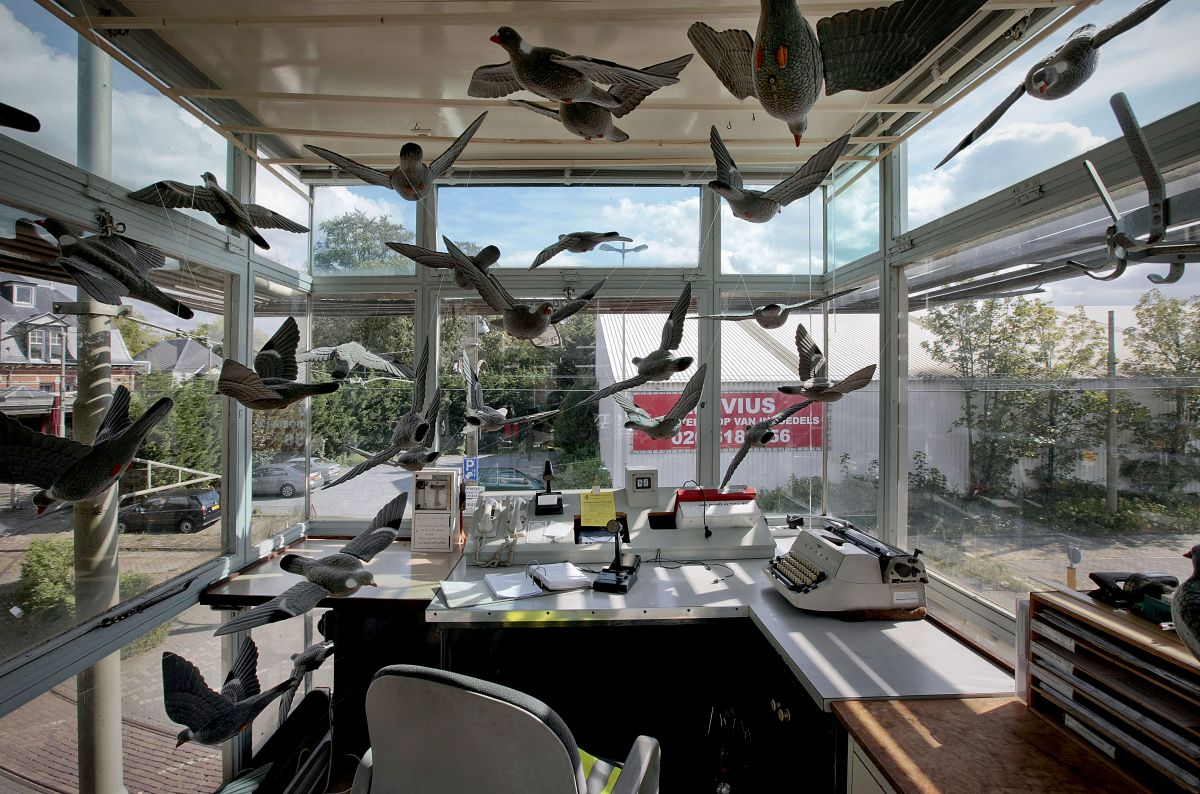
Marisol Ferradás (ES) DE DUIVENTIL, 2011
Mixed Media installation,
Havenstraat 1, Amsterdam
Marisol Ferradás is the initiator of the project Kunst aan de Schinkel and the owner of the Soledad Senlle Gallery. For Ferradás, art is an inspiring medium through which to communicate with people. She devises interventions with her art projects in order to communicate with unknown people. She consciously works from her own feelings and experiences and in this way tries to push through into the core of an encounter with another.
The ‘Eindpunt’ is a wooden cabin on the grounds of Museumtramlijn at the Haarlemmermeerstation. Tram and train travellers’ stories will be featured in this cabin as audio recordings. Ferradás has searched for stories from travellers, who instead of shutting themselves off in a media cocoon discuss their ups and downs with perfect strangers, just like olden days. She carries out these intimate discussions without the inhibitions, which come with meeting again.
In addition to ‘Eindpunt’, Ferradás is also exhibiting a project at Museumtramlijn. Near the Schinkelkade and across from the depot is the Havenstraat House of Detention. Many people in the neighbourhood aren’t even aware that there is such a facility in the Havenstraat. With her project ‘De duiventil’, Ferradás involves the detainees in the art manifestation in an indirect manner. Across from the House of Detention is a traffic regulation cabin, the dovecot, which houses an installation consisting of a multitude
of doves.
Marisol Ferradás [Portas, 1961] is a self-taught artist. In her exhibition ‘Un moment inconditionnel’ [2009] at the Soledad Senlle Gallery she transformed the space into a sandy desert in which she showed an installation as well as video art. For a project in the Vondelpark ‘L’arbre aux secrets’ [2008], Ferradás collected wishes – experiences, which were sealed with wax in ceramic jars. The jars were then buried in the Indian Thar desert and a bit of the desert was brought back by the artist to the gallery on the
Sloterkade.
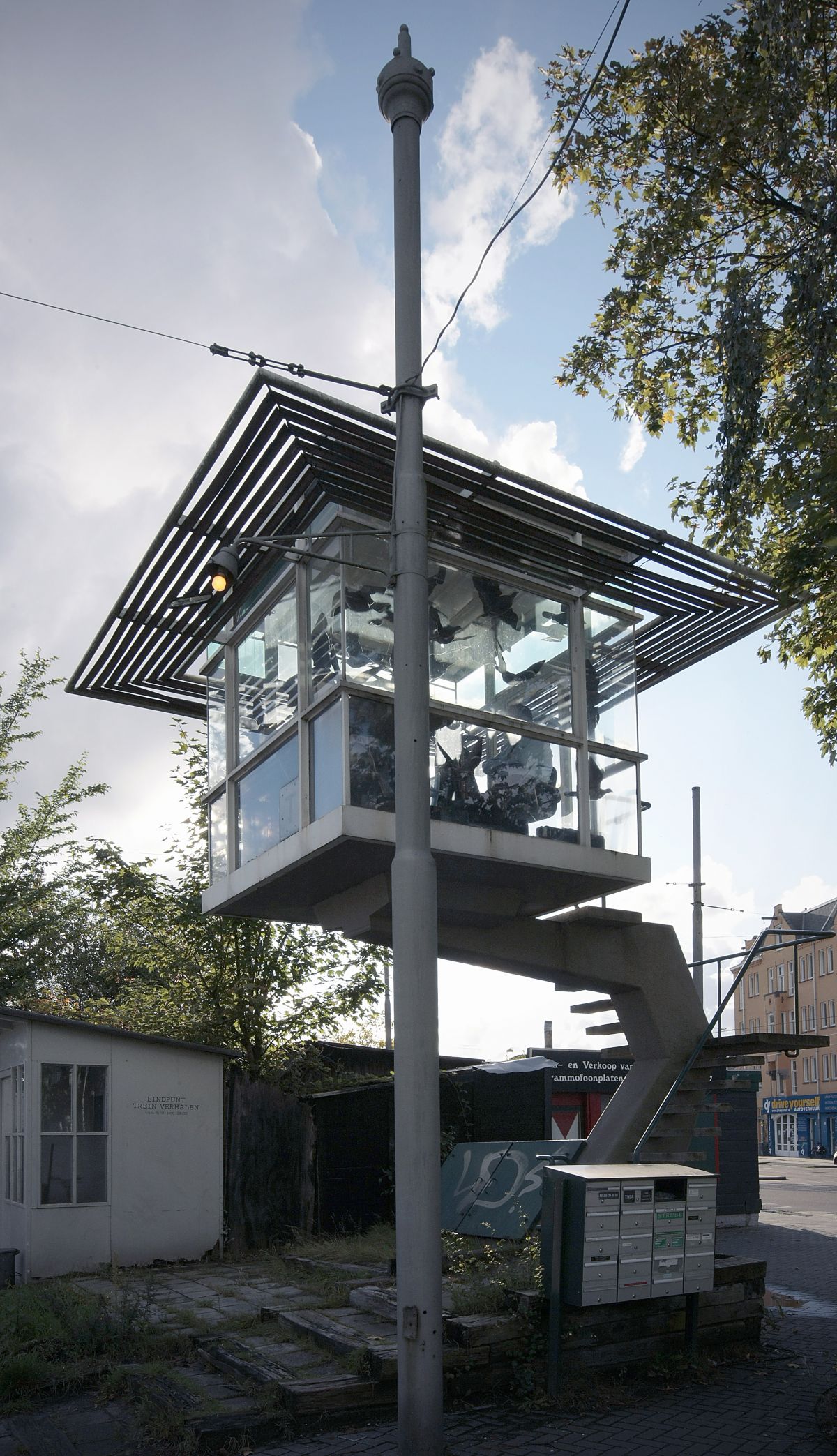
Marisol Ferradás (ES) DE DUIVENTIL, 2011
Mixed Media installation,
Havenstraat 1, Amsterdam
Marisol Ferradás is the initiator of the project Kunst aan de Schinkel and the owner of the Soledad Senlle Gallery. For Ferradás, art is an inspiring medium through which to communicate with people. She devises interventions with her art projects in order to communicate with unknown people. She consciously works from her own feelings and experiences and in this way tries to push through into the core of an encounter with another.
The ‘Eindpunt’ is a wooden cabin on the grounds of Museumtramlijn at the Haarlemmermeerstation. Tram and train travellers’ stories will be featured in this cabin as audio recordings. Ferradás has searched for stories from travellers, who instead of shutting themselves off in a media cocoon discuss their ups and downs with perfect strangers, just like olden days. She carries out these intimate discussions without the inhibitions, which come with meeting again.
In addition to ‘Eindpunt’, Ferradás is also exhibiting a project at Museumtramlijn. Near the Schinkelkade and across from the depot is the Havenstraat House of Detention. Many people in the neighbourhood aren’t even aware that there is such a facility in the Havenstraat. With her project ‘De duiventil’, Ferradás involves the detainees in the art manifestation in an indirect manner. Across from the House of Detention is a traffic regulation cabin, the dovecot, which houses an installation consisting of a multitude
of doves.
Marisol Ferradás [Portas, 1961] is a self-taught artist. In her exhibition ‘Un moment inconditionnel’ [2009] at the Soledad Senlle Gallery she transformed the space into a sandy desert in which she showed an installation as well as video art. For a project in the Vondelpark ‘L’arbre aux secrets’ [2008], Ferradás collected wishes – experiences, which were sealed with wax in ceramic jars. The jars were then buried in the Indian Thar desert and a bit of the desert was brought back by the artist to the gallery on the
Sloterkade.
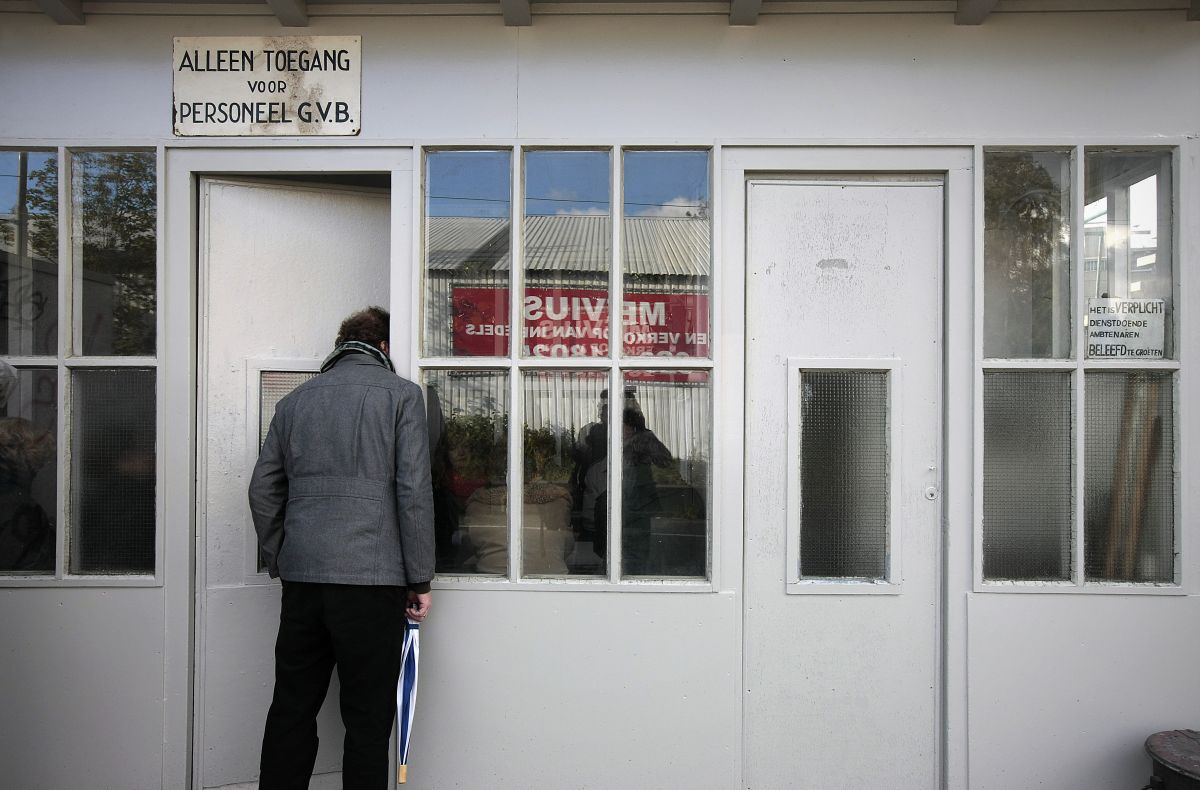
Marisol Ferradás (ES) Eindpunt, 2011
Audio installation,
Eindpunt huisje, Amsterdam
Marisol Ferradás is the initiator of the project Kunst aan de Schinkel and the owner of the Soledad Senlle Gallery. For Ferradás, art is an inspiring medium through which to communicate with people. She devises interventions with her art projects in order to communicate with unknown people. She consciously works from her own feelings and experiences and in this way tries to push through into the core of an encounter with another.
The ‘Eindpunt’ is a wooden cabin on the grounds of Museumtramlijn at the Haarlemmermeerstation. Tram and train travellers’ stories will be featured in this cabin as audio recordings. Ferradás has searched for stories from travellers, who instead of shutting themselves off in a media cocoon discuss their ups and downs with perfect strangers, just like olden days. She carries out these intimate discussions without the inhibitions, which come with meeting again.
In addition to ‘Eindpunt’, Ferradás is also exhibiting a project at Museumtramlijn. Near the Schinkelkade and across from the depot is the Havenstraat House of Detention. Many people in the neighbourhood aren’t even aware that there is such a facility in the Havenstraat. With her project ‘De duiventil’, Ferradás involves the detainees in the art manifestation in an indirect manner. Across from the House of Detention is a traffic regulation cabin, the dovecot, which houses an installation consisting of a multitude
of doves.
Marisol Ferradás [Portas, 1961] is a self-taught artist. In her exhibition ‘Un moment inconditionnel’ [2009] at the Soledad Senlle Gallery she transformed the space into a sandy desert in which she showed an installation as well as video art. For a project in the Vondelpark ‘L’arbre aux secrets’ [2008], Ferradás collected wishes – experiences, which were sealed with wax in ceramic jars. The jars were then buried in the Indian Thar desert and a bit of the desert was brought back by the artist to the gallery on the
Sloterkade.
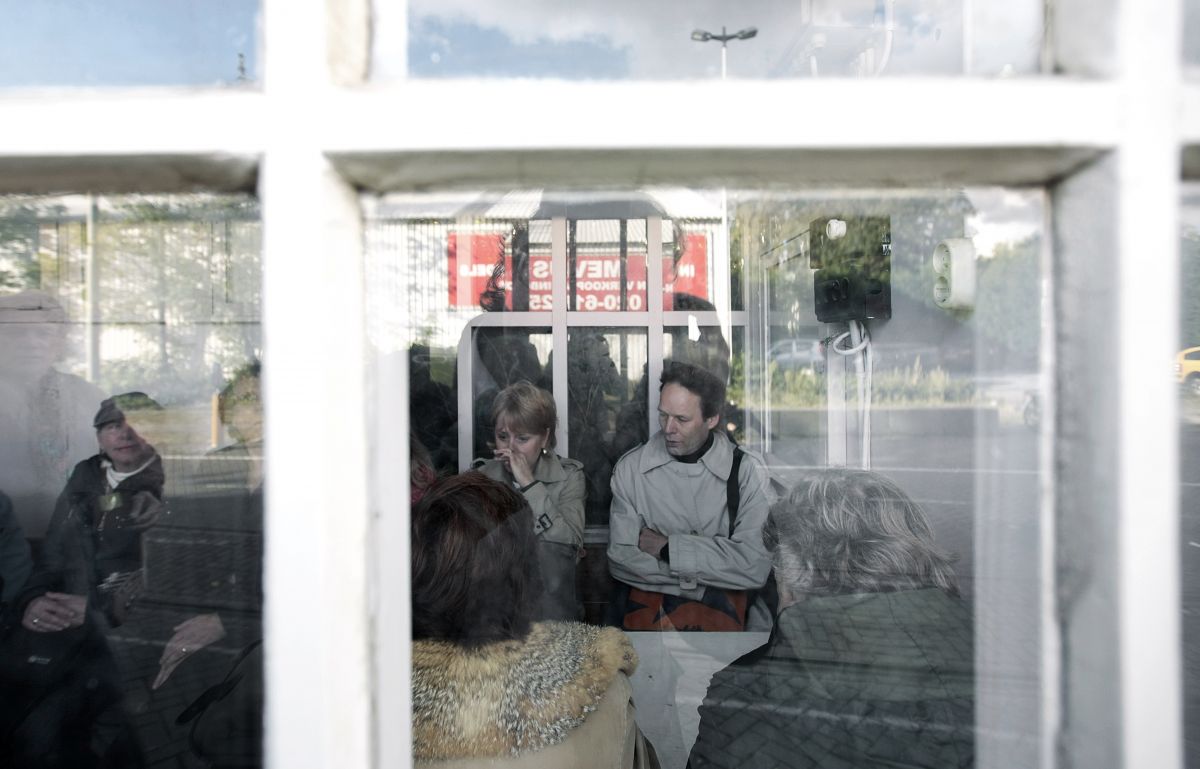
Marisol Ferradás (ES) Eindpunt, 2011
Audio installation,
Eindpunt huisje, Amsterdam
Marisol Ferradás is the initiator of the project Kunst aan de Schinkel and the owner of the Soledad Senlle Gallery. For Ferradás, art is an inspiring medium through which to communicate with people. She devises interventions with her art projects in order to communicate with unknown people. She consciously works from her own feelings and experiences and in this way tries to push through into the core of an encounter with another.
The ‘Eindpunt’ is a wooden cabin on the grounds of Museumtramlijn at the Haarlemmermeerstation. Tram and train travellers’ stories will be featured in this cabin as audio recordings. Ferradás has searched for stories from travellers, who instead of shutting themselves off in a media cocoon discuss their ups and downs with perfect strangers, just like olden days. She carries out these intimate discussions without the inhibitions, which come with meeting again.
In addition to ‘Eindpunt’, Ferradás is also exhibiting a project at Museumtramlijn. Near the Schinkelkade and across from the depot is the Havenstraat House of Detention. Many people in the neighbourhood aren’t even aware that there is such a facility in the Havenstraat. With her project ‘De duiventil’, Ferradás involves the detainees in the art manifestation in an indirect manner. Across from the House of Detention is a traffic regulation cabin, the dovecot, which houses an installation consisting of a multitude
of doves.
Marisol Ferradás [Portas, 1961] is a self-taught artist. In her exhibition ‘Un moment inconditionnel’ [2009] at the Soledad Senlle Gallery she transformed the space into a sandy desert in which she showed an installation as well as video art. For a project in the Vondelpark ‘L’arbre aux secrets’ [2008], Ferradás collected wishes – experiences, which were sealed with wax in ceramic jars. The jars were then buried in the Indian Thar desert and a bit of the desert was brought back by the artist to the gallery on the
Sloterkade.
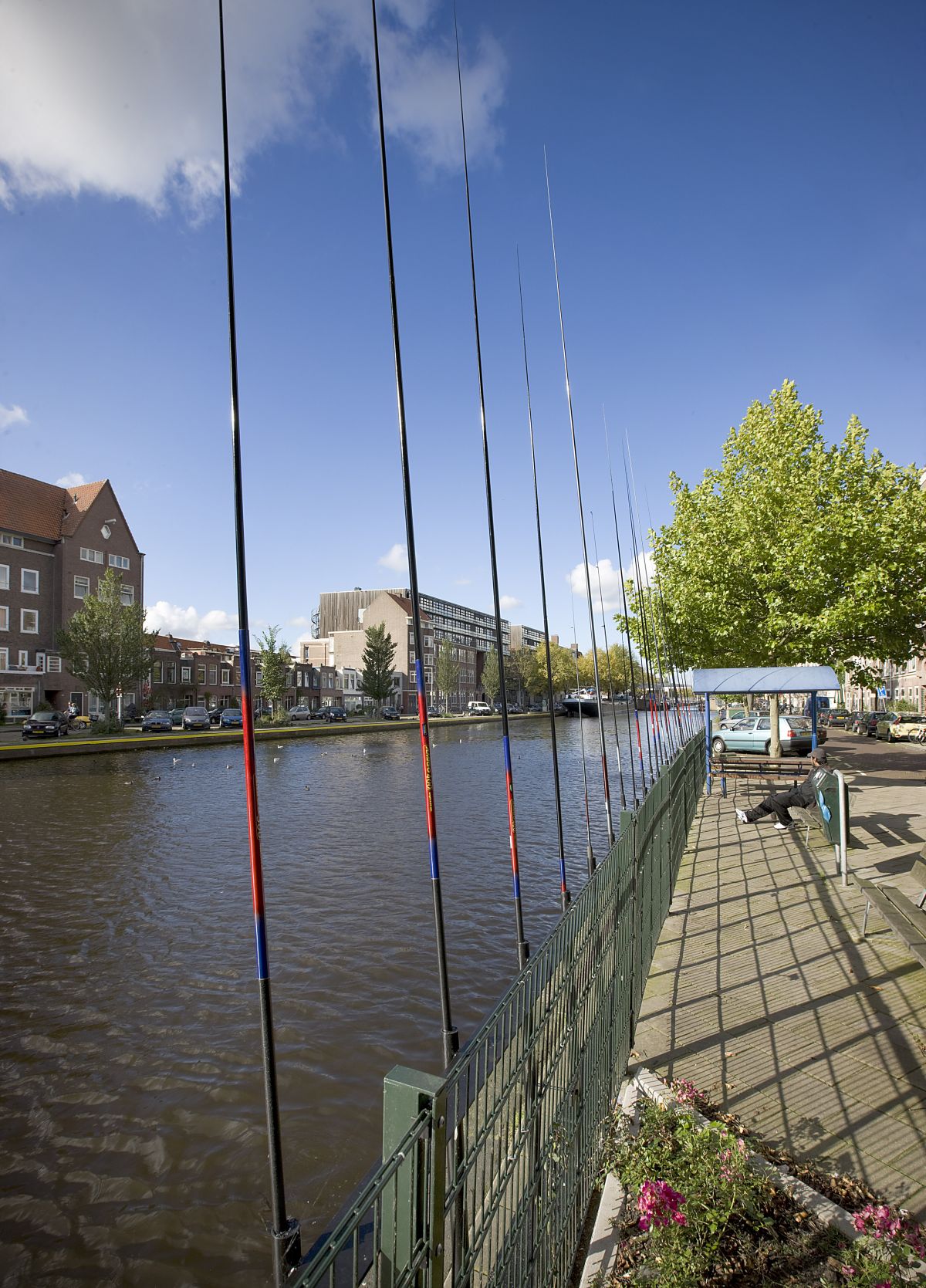
Maze de Boer (NL) Fishing Vliet, 2011
32 fishingrods, installation 3–9 × 12 m,
Schinkelkade/Vlietstraat, Amsterdam
Along the Schinkel and next to the Vlietstraat is a small triangular square. The square borders on the tram depot and from the water it seems as though this is the last bit of public road. A picnic table sheltered by a roof, a tree, a lamppost and two little benches furnish the square. A solid fence along the quay ensures the safety of playing children, whilst giving them a nice view on the Schinkel. Maze de Boer found his inspiration for this location in an impressive image of countless fishing rods on the Bosporus bridge in Istanbul. A large number of fishing rods will also be placed along the Schinkel, each standing next to the other, proudly pointing upwards and hardly bending over the quay. With ‘Fishing Vliet’ Maze de Boer wishes to provoke a specific illusion, which the observer is then able to experience as real.
The fascination with illusion is characteristic and essential in the work of multidisciplinary artist Maze de Boer. He gained recognition with his installation ‘Temporary Station: Post CS’ 2005, as newspapers and television programmes reported on the large, spacious installation, which took on the form of a metro station. The station, located in the basement of the former TPG Post building in Amsterdam, was so realistic that people stood and waited several minutes for the metro to arrive.
Maze de Boer [Amsterdam, 1976] studied at the Gerrit Rietveld Academy and the Rijksakademie van beeldende kunsten.
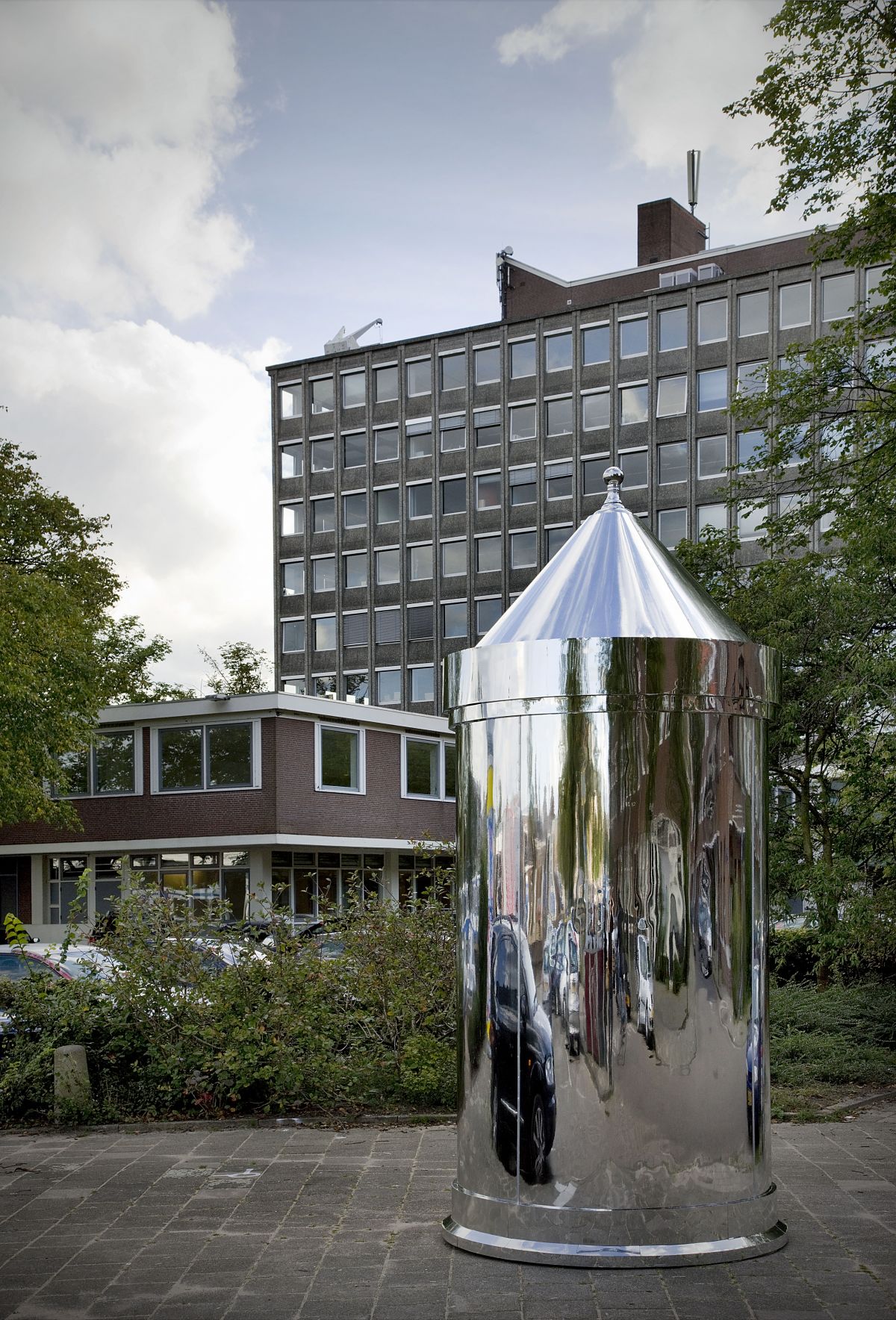
Mischa Rakier (NL) Spiegelzuil, 2011
Wood, metal and mirror material 1.5 × 3.8 m,
Rijnsburgstraat/Kromme Leimuidenstraat, Amsterdam
The start, or end, of the Sloterkade can be described as a triangular area where the Sloterkade branches off and changes into the Rijnsburgstraat. The water of the Schinkel, the road and a large office building all contain the area. The triangle itself mainly consists of parking spaces. As his contribution to the Kunst aan de Schinkel project, Mischa Rakier places an archetype of the traditional Dutch ‘pepperbox’ [a column used for advertising] at the heart of these parking spaces where it is visible from all angles. The artist uses the shape of the classic transformer column, still a common sight on Amsterdam’s streets, as the basis for his work. He has carefully covered the entire structure with mirror material.
The ‘Spiegelzuil’ [The mirror column] can be summed up as a historic collective ‘marker’ or visual landmark of the neighbourhood, which is clearly visible and attracts attention from all directions. Look, this is where the Sloterkade begins! The mirror column is an interactive piece as everything in its direct environment is automatically taken up in the artwork itself: literally reflecting the neighbourhood and unexpectedly changing at any given moment of the day. Mischa Rakier’s work directly involves the general public, not only as viewers but also as subjects in the work.
Mischa Rakier [Delft, 1970] studied at the Hoge School voor de Kunsten in Arnhem and the Myndlysta-og-Handídaskólidad in Reykjavik, Iceland. After his studies he was artist-in-residence for two years at De Ateliers in Amsterdam and followed an Art History course at the University of Amsterdam. Mischa Rakier has exhibited in various locations in the Netherlands and abroad. His work is included in a number of private and corporate collections. Last year he was the winner of the Vermeulen Braukman Art Prize 2010, within the framework of the GOUD exhibition in the Museum Catharijneconvent in Utrecht.
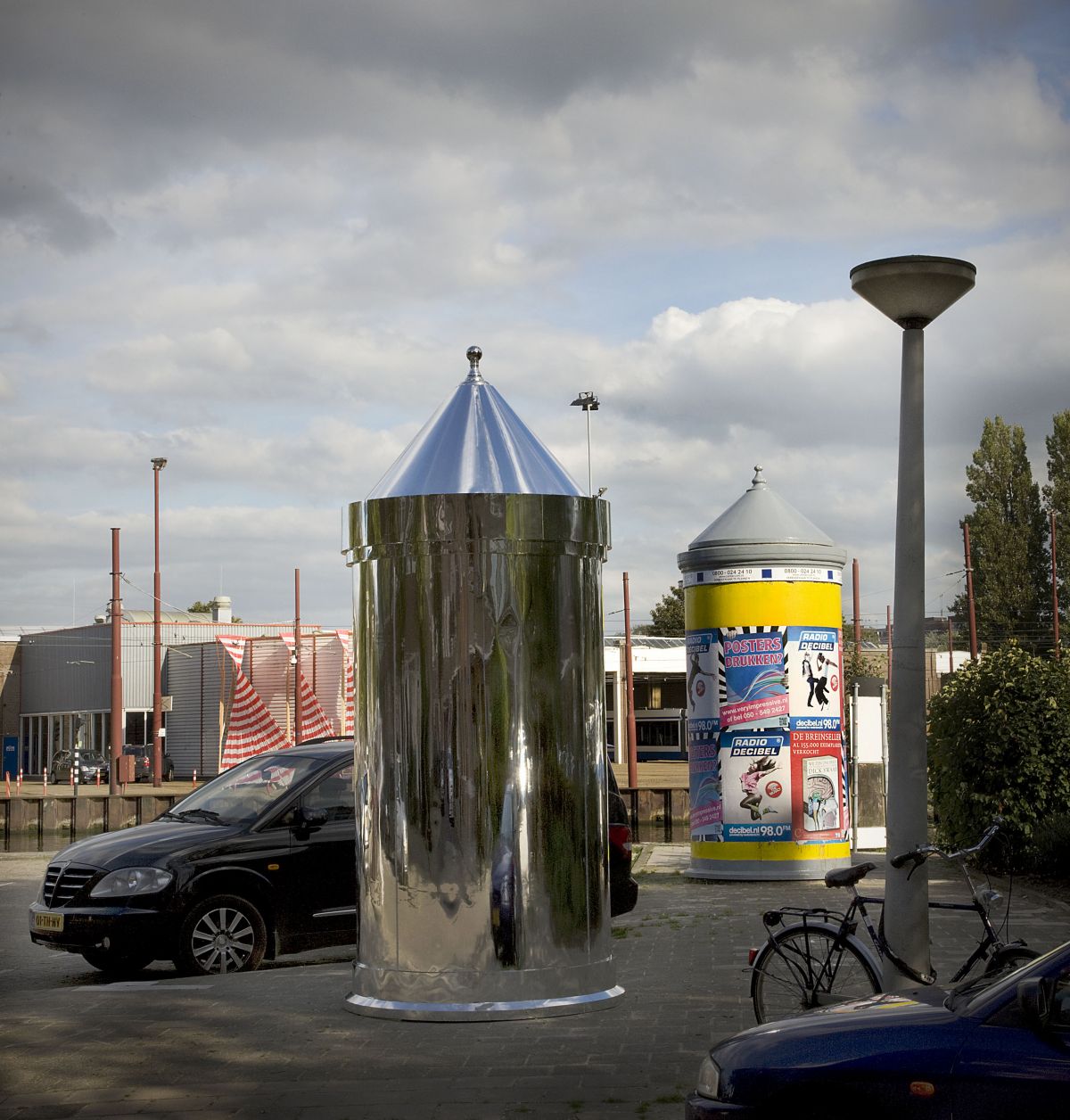
Mischa Rakier (NL) Spiegelzuil, 2011
Wood, metal and mirror material 1.5 × 3.8 m,
Rijnsburgstraat/Kromme Leimuidenstraat, Amsterdam
The start, or end, of the Sloterkade can be described as a triangular area where the Sloterkade branches off and changes into the Rijnsburgstraat. The water of the Schinkel, the road and a large office building all contain the area. The triangle itself mainly consists of parking spaces. As his contribution to the Kunst aan de Schinkel project, Mischa Rakier places an archetype of the traditional Dutch ‘pepperbox’ [a column used for advertising] at the heart of these parking spaces where it is visible from all angles. The artist uses the shape of the classic transformer column, still a common sight on Amsterdam’s streets, as the basis for his work. He has carefully covered the entire structure with mirror material.
The ‘Spiegelzuil’ [The mirror column] can be summed up as a historic collective ‘marker’ or visual landmark of the neighbourhood, which is clearly visible and attracts attention from all directions. Look, this is where the Sloterkade begins! The mirror column is an interactive piece as everything in its direct environment is automatically taken up in the artwork itself: literally reflecting the neighbourhood and unexpectedly changing at any given moment of the day. Mischa Rakier’s work directly involves the general public, not only as viewers but also as subjects in the work.
Mischa Rakier [Delft, 1970] studied at the Hoge School voor de Kunsten in Arnhem and the Myndlysta-og-Handídaskólidad in Reykjavik, Iceland. After his studies he was artist-in-residence for two years at De Ateliers in Amsterdam and followed an Art History course at the University of Amsterdam. Mischa Rakier has exhibited in various locations in the Netherlands and abroad. His work is included in a number of private and corporate collections. Last year he was the winner of the Vermeulen Braukman Art Prize 2010, within the framework of the GOUD exhibition in the Museum Catharijneconvent in Utrecht.
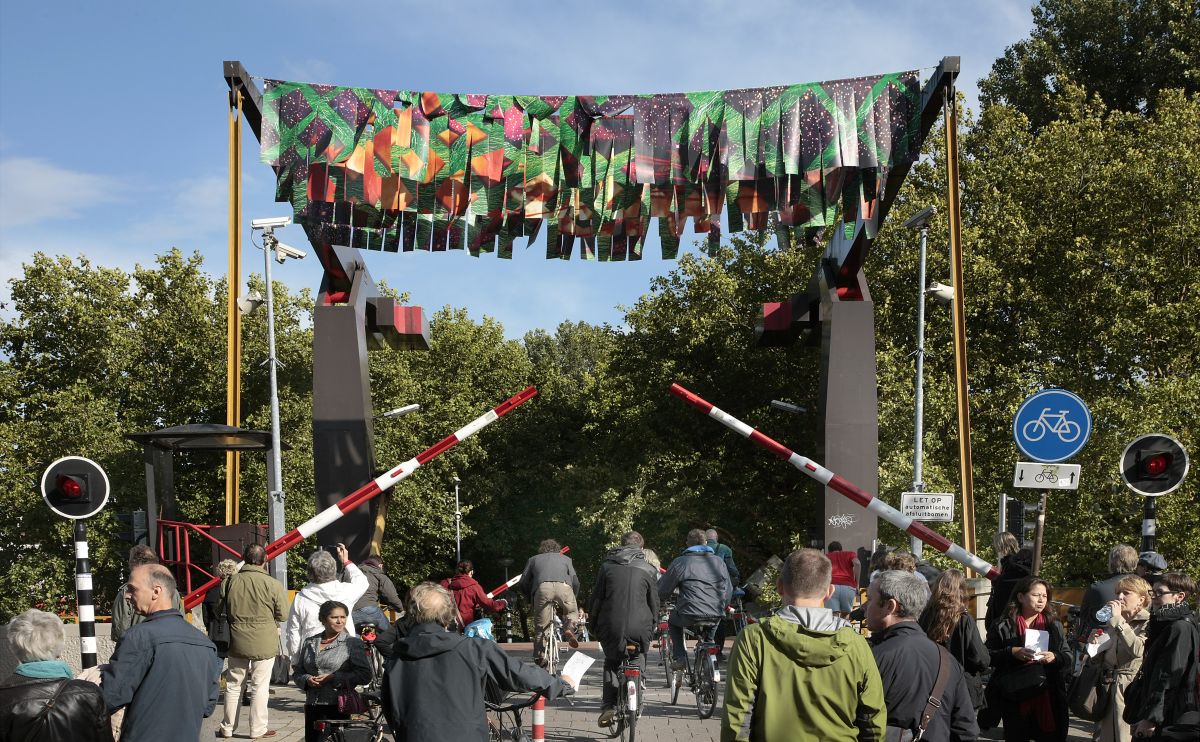
Natascha Rosling (UK) Shift, 2011
Inkjet on PVC, 11 x 6 m,
Theophile de Bockbrug, Amsterdam
Natasha Rosling is known for her monumental installations and sculptures with a playful and humorous character. Although not directly interactive, her works seem almost to invite the observer to play, to touch, to lean into or squeeze through the installation. Despite their large and brightly coloured surfaces, thick lines and unwieldy shapes, her sculptures evoke a sense of lightness. For the Kunst aan de Schinkel project Natasha Rosling has produced an installation across the arms of the drawbridge by the Theophile de Bockstraat. When the bridge is closed the work hangs in four equal vertical strips, yet when the bridge opens they form a horizontal field and a collage of contrasting visual surfaces. The movement of the bridge creates a sense of animation. Rosling based her installation on the existing physical components and elements of the bridge and its surroundings. With her visual imagery the artist aims to underline the existing characteristic features of the bridge on the one hand, and create a unique new atmosphere on the other.
Natasha Rosling [London, 1985] studied at the Chelsea College of Art and Design in London and the Sandberg Institute in Amsterdam. She has exhibited on an international
level at institutions such as the OCAT Centre of Contemporary Art with Vision Forum in China, Sculpture Space in the USA, Bajidala Centre of Contemporary Art in Mali, Hidde van Seggelen Gallery in London and W139 in Amsterdam. In late 2011 she will have a solo exhibition at the outLINE foundation in Amsterdam and is participating in a group exhibition at Jeu de Paume in Paris.
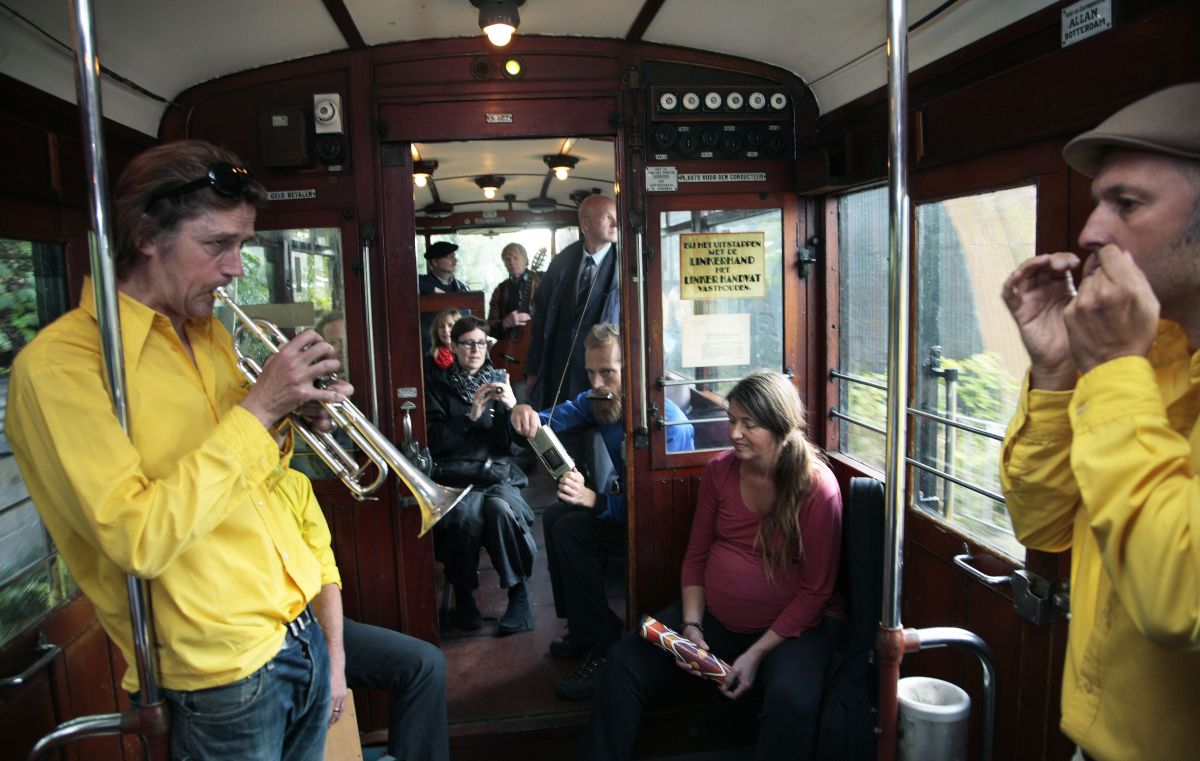
Oorbeek (NL) Music performance, 2011
Music performance,
Old tram, Museumtramlijn, Amsterdam
OORBEEK mangles misunderstood genres, stutters on or off the beat.
OORBEEK always begins again, though not at the same time
OORBEEK takes the detour and hops through sonic swamps.
OORBEEK cheats on the rules and takes harmony for a spin.
OORBEEK is the most yellow music band in the world.
OORBEEK is the folk music of the 21st century.
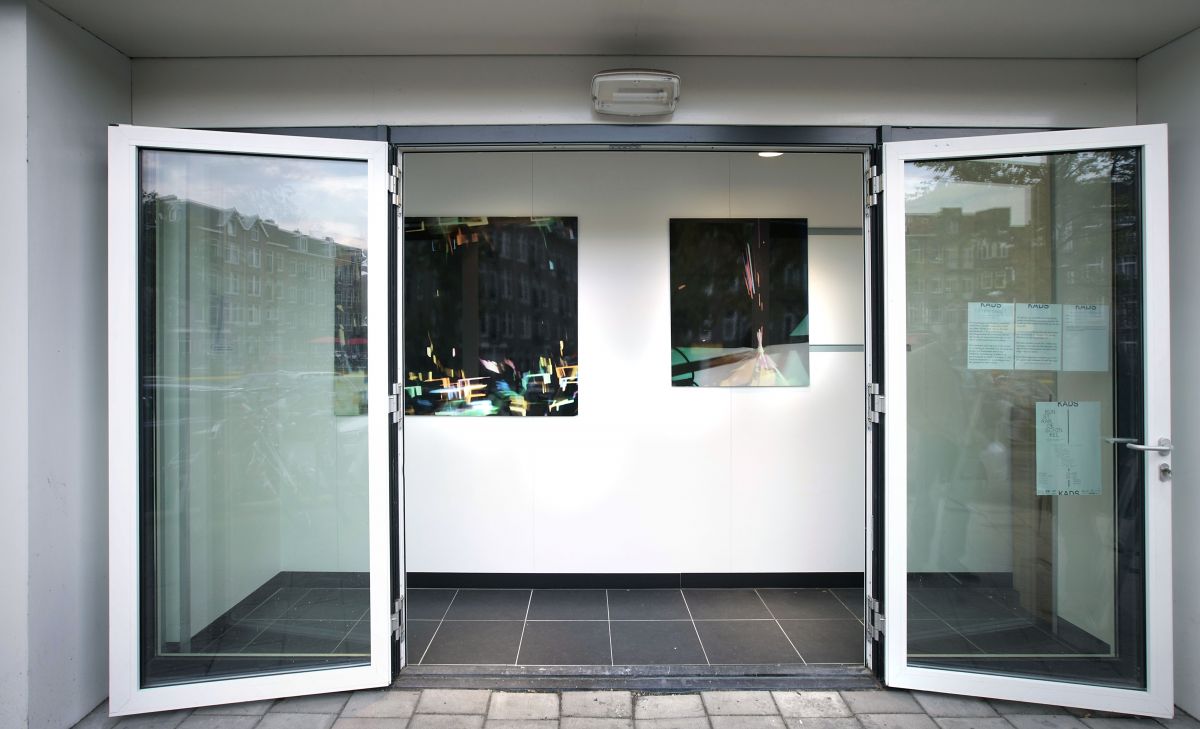
Peter Cleutjens (NL) Trashcan, 2011
C-Print on Aluminium, 118 × 84 cm & 120 × 148 cm,
Hema, Sloterkade 133a, Amsterdam
Peter Cleutjens assembles photography, drawing and painting into abstract and landscape representations. He makes photograms [photography without a camera], experiments in the dark room and manipulates his images by hand as well as with a computer. His systematic approach in framing, lighting and manipulation has allowed him to develop his own, layered imagery.
For the Kunst aan de Schinkel project, Cleutjens has made a type of alternative topographical atlas of the Schinkel area, using the waste available in the area as his basis. During the event his work will be shown in the shop window of the HEMA on the Sloterkade. As a result of his methodology and his alternative use of multiple points of light and differences in colour, the subject of his photogram, a waste object found in the Schinkel area, is now almost un-recognisable.
Cleutjens’ spatial registrations deliver alienating images. In a playful happening during the manifestation, the artist will give away a photographic work to the visitor who can identify, by means of drawings or photographs,the object used in the artwork. With this, he wishes to make visitors aware, to stimulate and urge interaction. Luckily there are a few clues: a booklet specially made by the artist introduces visitors to his methodical work process. It helps the viewer to find the answer to the competition. All entries will be exhibited next to the artwork in the HEMA window. Cleutjens was inspired, for his interactive project, by the key work of Stanley Brouwn ‘This Way Brouwn’, in which passers-by were asked to explain on a piece of paper how to get from point A to point B.
Peter Cleutjens [Roermond, 1967] studied at the Academy of Fine Arts in Maastricht and the Rijksakademie in Amsterdam. He has won many prizes and grants and has exhibited in the Netherlands as well as abroad.
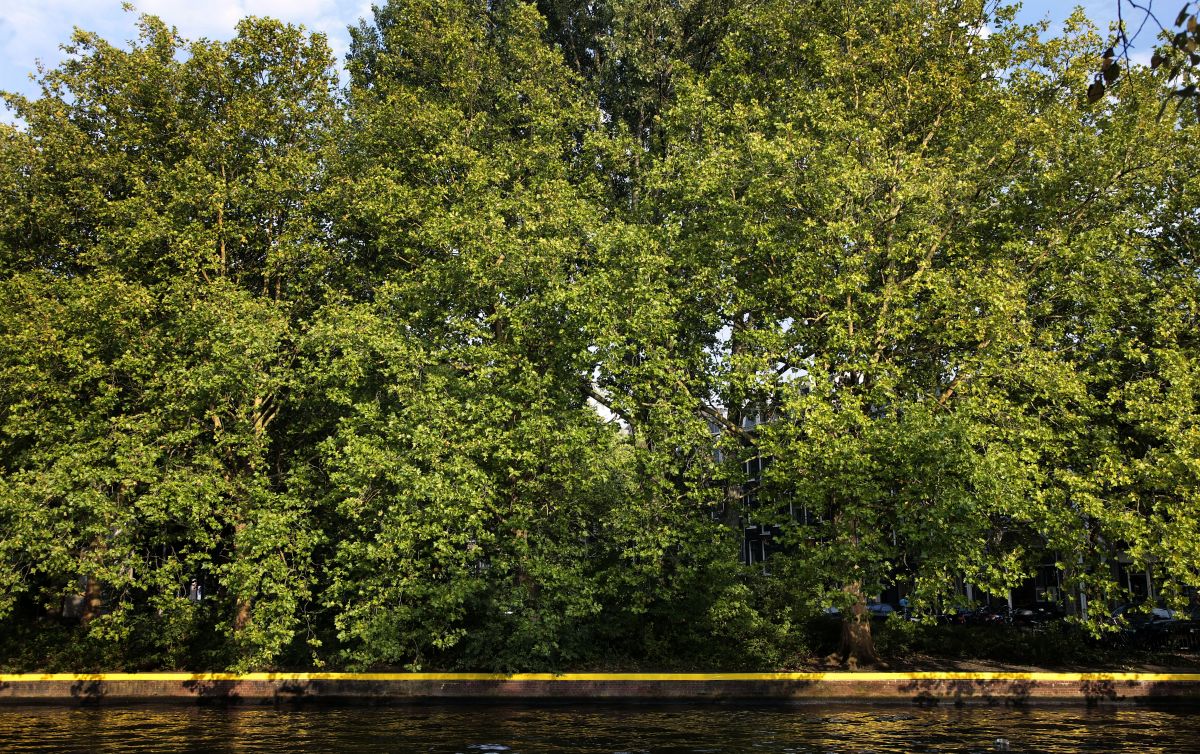
Peter Vink (NL) De Schinkel, 2011
Yellow tape, 2 quays 900 M × 15 cm,
The Schinkel, Amsterdam
Peter Vink almost exclusively makes works that are site-specific and in public spaces. He incorporates the specific characteristics of the space or environment, aiming to emphasise or strengthen what is present in order to influence and highlight our experience of the site. By breaking through our conditioned perception, Vink hopes to change the way people experience their environment.
For the Kunst aan de Schinkel project, Peter Vink has marked both quays of the Schinkel with yellow tape. This minimal intervention has a strong visual, signalling effect and emphasises the Schinkel waterway. The lines can be seen as the connecting factor of the art manifestation as they indicate the area where the Kunst aan de Schinkel project takes place. Vink’s work can also be seen as a socially engaging project within the public domain. An important role has been set aside, for workers in the area. The project was in fact installed with help from members of the sheltered workshop in the Schinkel neighbourhood.
Peter Vink [De Bilt, 1974] studied at the Gerrit Rietveld Academy. He has exhibited on an international level and has realised various art commissions in the public domain. For the Government Buildings Agency [Rijksgebouwendienst] he created a work for the joint depot of Naturalis, Museum Boerhaave and the Dutch National Museum of Antiquities [RMO] in Leiden. Commissioned by Skor, he has recently realised a light installation in Enschede. Peter Vink was artist in residence at Platform China, Beijing,
China Foundation for Visual Arts, Design and Architecture.
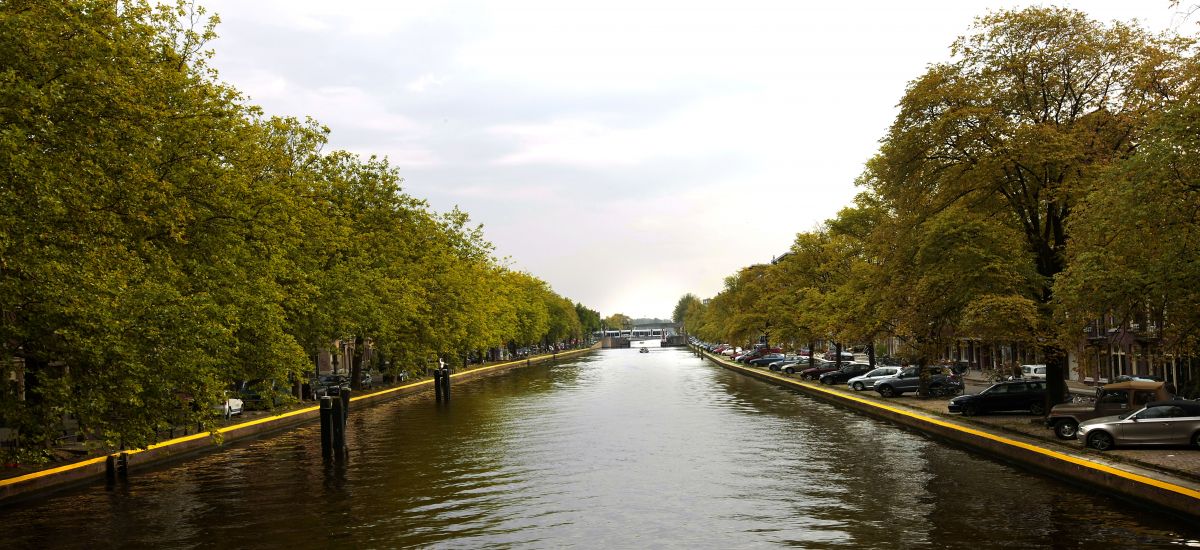
Peter Vink (NL) De Schinkel, 2011
Yellow tape, 2 quays 900 M × 15 cm,
The Schinkel, Amsterdam
Peter Vink almost exclusively makes works that are site-specific and in public spaces. He incorporates the specific characteristics of the space or environment, aiming to emphasise or strengthen what is present in order to influence and highlight our experience of the site. By breaking through our conditioned perception, Vink hopes to change the way people experience their environment.
For the Kunst aan de Schinkel project, Peter Vink has marked both quays of the Schinkel with yellow tape. This minimal intervention has a strong visual, signalling effect and emphasises the Schinkel waterway. The lines can be seen as the connecting factor of the art manifestation as they indicate the area where the Kunst aan de Schinkel project takes place. Vink’s work can also be seen as a socially engaging project within the public domain. An important role has been set aside, for workers in the area. The project was in fact installed with help from members of the sheltered workshop in the Schinkel neighbourhood.
Peter Vink [De Bilt, 1974] studied at the Gerrit Rietveld Academy. He has exhibited on an international level and has realised various art commissions in the public domain. For the Government Buildings Agency [Rijksgebouwendienst] he created a work for the joint depot of Naturalis, Museum Boerhaave and the Dutch National Museum of Antiquities [RMO] in Leiden. Commissioned by Skor, he has recently realised a light installation in Enschede. Peter Vink was artist in residence at Platform China, Beijing,
China Foundation for Visual Arts, Design and Architecture.
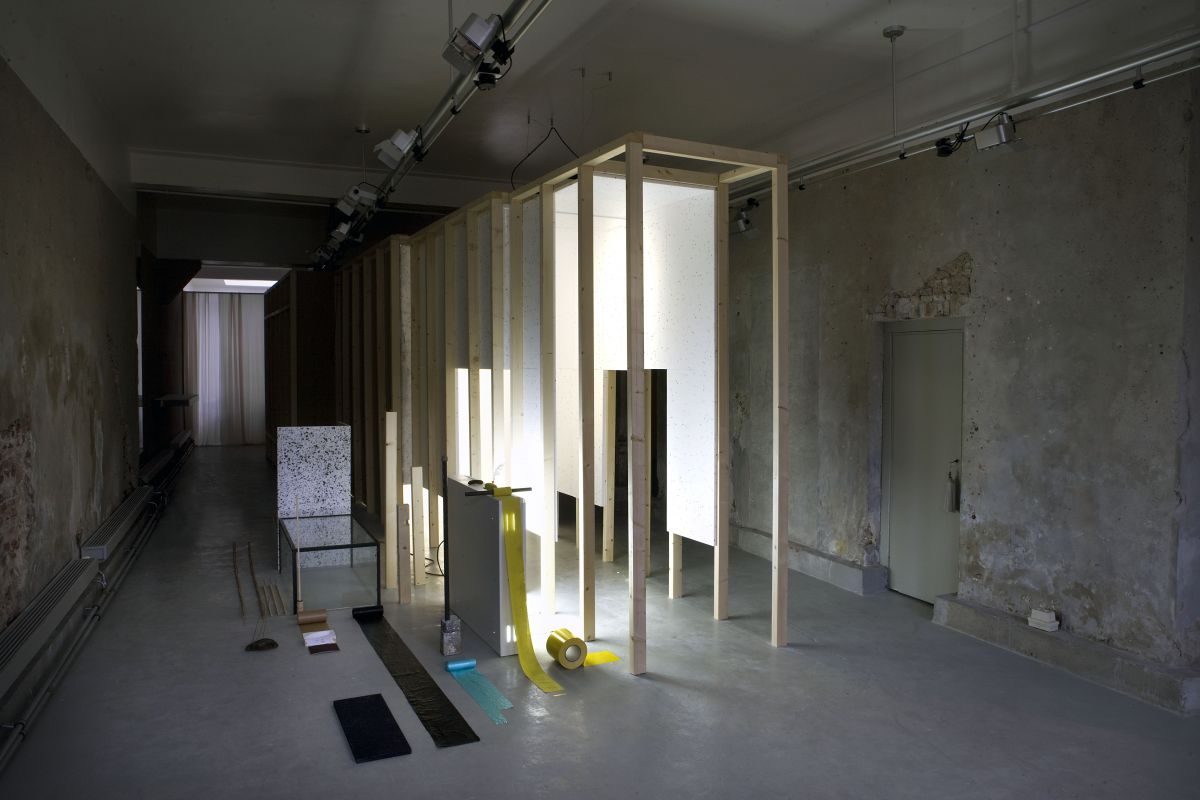
Saskia Noor van Imhoff (CA/NL) # + 03.00, 2011, 2011
Mixed media installation 9 × 1.30 × 2.30 m,
Sloterkade 171, Amsterdam
Saskia Noor van Imhoff has been making site-specific work since 2008, which she places in an extensive perspective. Her archival projects are continual installations taking on different shapes and compositions, depending on the circumstances. The work derives from a need to present a non-hierarchic perspective on the world. The artist searches for connections based on memory, association and location. The installations can be read as research rooms, in which the artist tries to figure out how something comes to originate. For the Kunst aan de Schinkel project, van Imhoff has created a three-dimensional installation for the Soledad Senlle Gallery, resembling an infinite passageway. It features a careful selection of fragments from Kunst aan de Schinkel artworks. Van Imhoff has researched how the participating artists have interpreted the past, and as such, has incorporated this into her own work. In addition to this, she also invited several of the artists to take part in her installation.
Saskia Noor van Imhoff [Mission, 1982] won the Gerrit Rietveld award with her graduate work, later purchased by the Verbeke Foundation in 2008. In 2010 she exhibited, amongst other places, at Huize Frankendael and Nieuw Dakota in Amsterdam. She is currently an artist-in-residence at De Ateliers. During the Kunst aan de Schinkel event, her work will be presented at three different locations in Amsterdam: at Huize Frankendael, at ARTS [office of GP De Boer] and at Jeanine Hofland contemporary art.
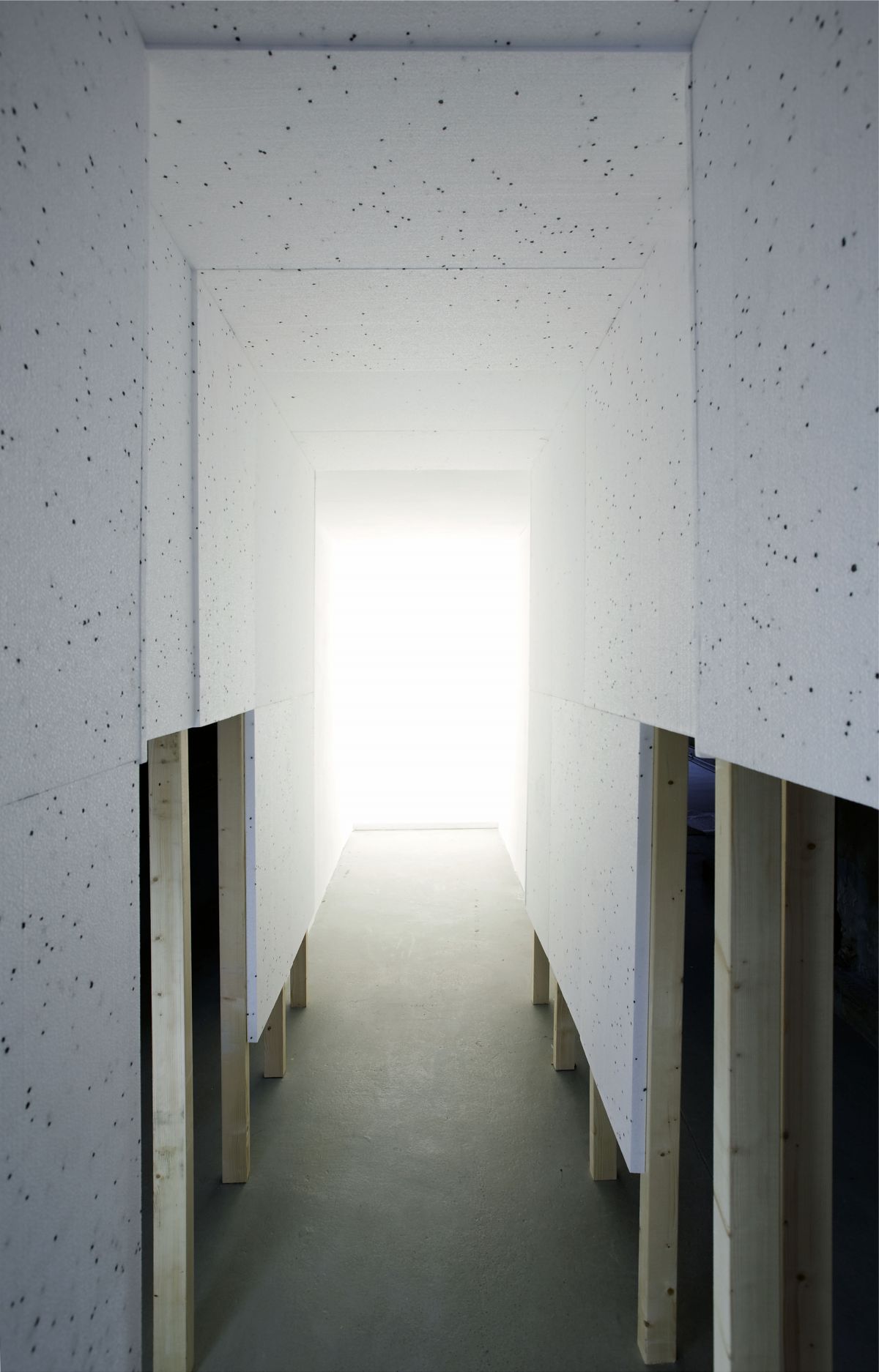
Saskia Noor van Imhoff (CA/NL) # + 03.00, 2011, 2011
Mixed media installation 9 × 1.30 × 2.30 m,
Sloterkade 171, Amsterdam
Saskia Noor van Imhoff has been making site-specific work since 2008, which she places in an extensive perspective. Her archival projects are continual installations taking on different shapes and compositions, depending on the circumstances. The work derives from a need to present a non-hierarchic perspective on the world. The artist searches for connections based on memory, association and location. The installations can be read as research rooms, in which the artist tries to figure out how something comes to originate. For the Kunst aan de Schinkel project, van Imhoff has created a three-dimensional installation for the Soledad Senlle Gallery, resembling an infinite passageway. It features a careful selection of fragments from Kunst aan de Schinkel artworks. Van Imhoff has researched how the participating artists have interpreted the past, and as such, has incorporated this into her own work. In addition to this, she also invited several of the artists to take part in her installation.
Saskia Noor van Imhoff [Mission, 1982] won the Gerrit Rietveld award with her graduate work, later purchased by the Verbeke Foundation in 2008. In 2010 she exhibited, amongst other places, at Huize Frankendael and Nieuw Dakota in Amsterdam. She is currently an artist-in-residence at De Ateliers. During the Kunst aan de Schinkel event, her work will be presented at three different locations in Amsterdam: at Huize Frankendael, at ARTS [office of GP De Boer] and at Jeanine Hofland contemporary art.
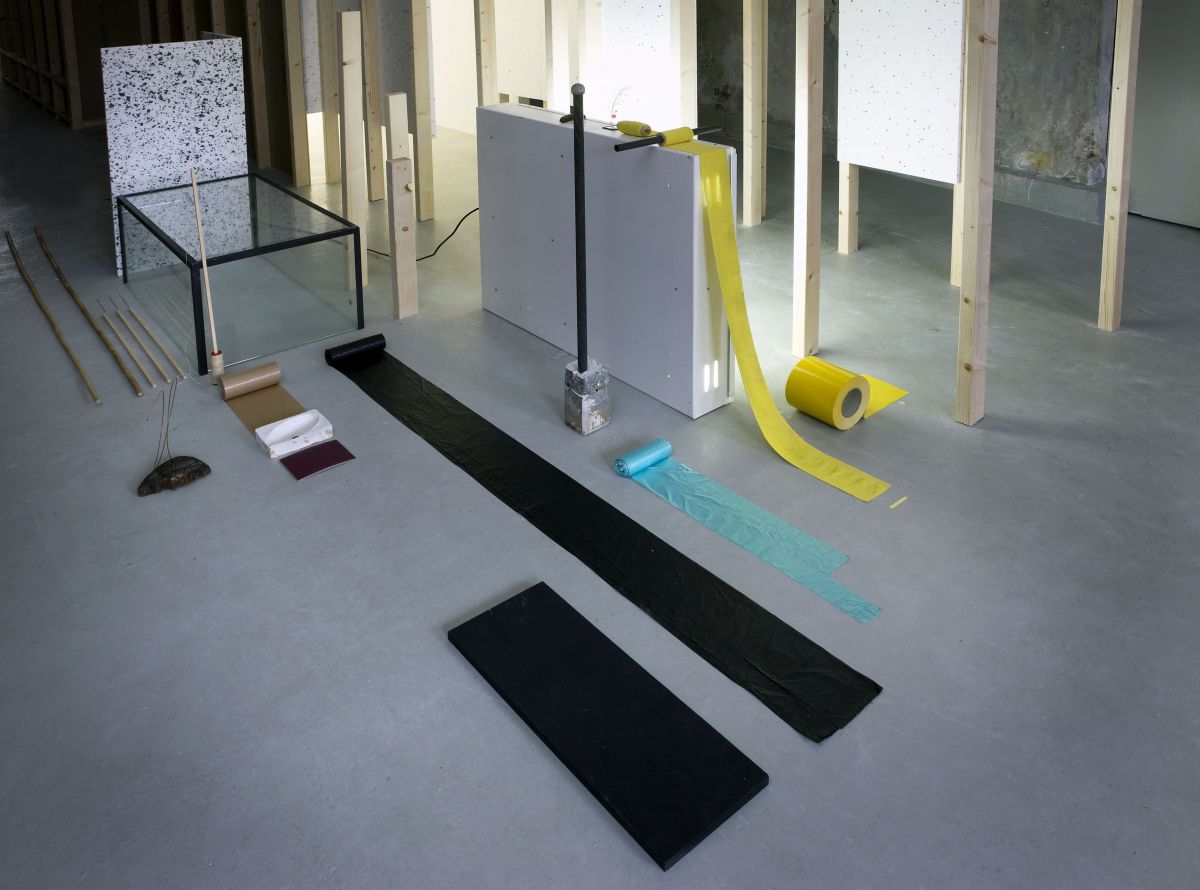
Saskia Noor van Imhoff (CA/NL) # + 03.00, 2011, 2011
Mixed media installation 9 × 1.30 × 2.30 m,
Sloterkade 171, Amsterdam
Saskia Noor van Imhoff has been making site-specific work since 2008, which she places in an extensive perspective. Her archival projects are continual installations taking on different shapes and compositions, depending on the circumstances. The work derives from a need to present a non-hierarchic perspective on the world. The artist searches for connections based on memory, association and location. The installations can be read as research rooms, in which the artist tries to figure out how something comes to originate. For the Kunst aan de Schinkel project, van Imhoff has created a three-dimensional installation for the Soledad Senlle Gallery, resembling an infinite passageway. It features a careful selection of fragments from Kunst aan de Schinkel artworks. Van Imhoff has researched how the participating artists have interpreted the past, and as such, has incorporated this into her own work. In addition to this, she also invited several of the artists to take part in her installation.
Saskia Noor van Imhoff [Mission, 1982] won the Gerrit Rietveld award with her graduate work, later purchased by the Verbeke Foundation in 2008. In 2010 she exhibited, amongst other places, at Huize Frankendael and Nieuw Dakota in Amsterdam. She is currently an artist-in-residence at De Ateliers. During the Kunst aan de Schinkel event, her work will be presented at three different locations in Amsterdam: at Huize Frankendael, at ARTS [office of GP De Boer] and at Jeanine Hofland contemporary art.
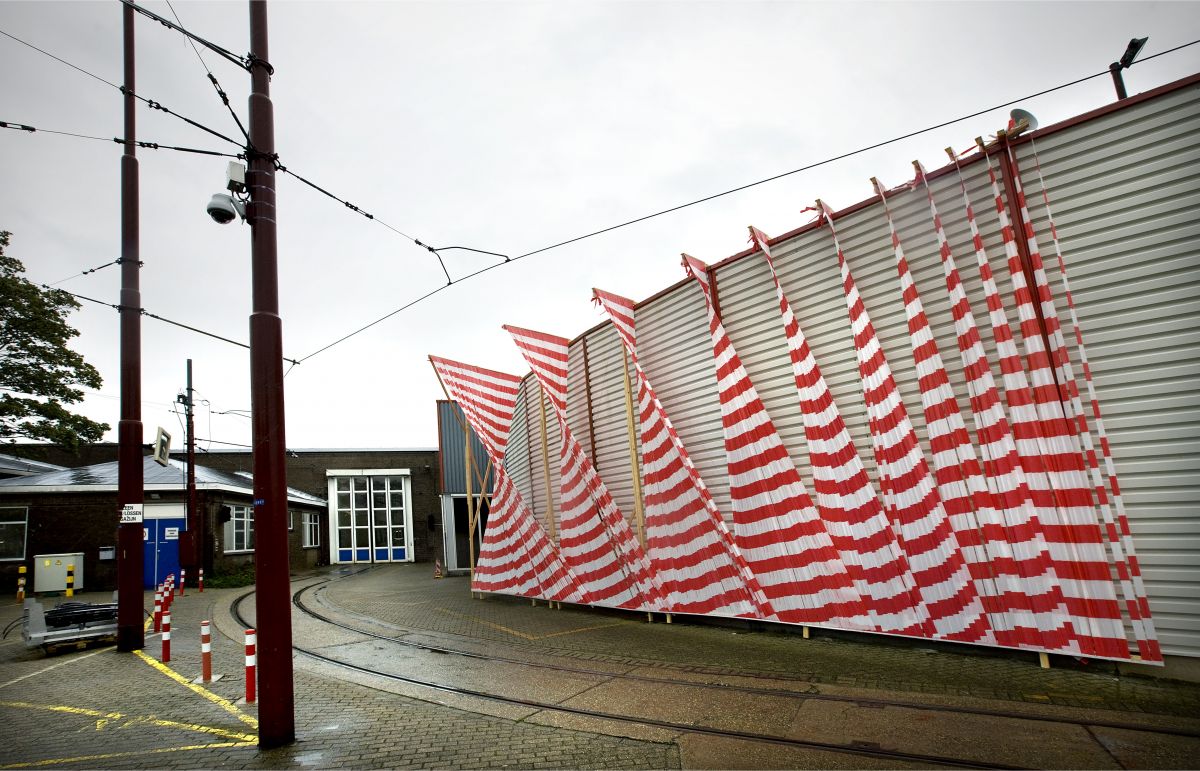
Theo Tomson (NL) Untitled [The Spinning Pit], 2011
Wood, marking tape, aluminium 13 × 7 × 3.20 m,
Tram remittance GVB Havenstraat, Amsterdam
For the Kunst aan de Schinkel project, Theo Tomson has created a monumental installation on the outside wall of the Havenstraat tram depot of the Amsterdam public transport company GVB, using red and white marking tape. The three-dimensional work, which is thirteen metres wide, seven metres high and at one point up to two metres deep, consists of three connecting parts of the depot wall. The red vertical lines stand out against the grey coloured depot, which GVB employees also dubbed ‘the spinning pit’, and form the major basis for Tomson’s project.
The tape is stretched between wooden beams. Every segment of tape ‘twists’ around its own longitudinal axis. In this manner the artist has created multiple inclining ’screens’ descending from large to small. By changing the dimensions, density and direction of these ‘screens’, it produces a dynamic that can be seen as a rhythmic composition.
The artist has been working with marking tape since 2006. He consciously plays with the context of the highly recognisable material and uses it to add another level to his work. An essential characteristic is the transience of the material in combination with the temporary nature of his projects in public spaces. Tomson has developed from the painterly into a specialist in making rhythmic compositions and structures with minimal means [such as tape, insulation material, stickers and marking tape]. An important starting point when creating his ‘studio work’ is the material he uses. Nevertheless, the specific qualities of the location play a greater role in terms of inspiration for his three-dimensional interventions.
Theo Tomson [Amsterdam, 1977] studied at the art academy in Kampen. He has exhibited in the Netherlands and abroad and has realised an array of site-specific works.